Idéale saddles are among the least understood classic bicycle components given their standout prominence and frequent exorbitant value. The dizzying array of models produced under the Idéale marque continues vexing even the most ardent collectors, who seem to enjoy the punishment received when combining obscurity of fact with broad product offerings and potential stratospheric price appreciation.
Oft-celebrated yet largely unknown Idéale saddles deserve their enigmatic reputation every bit as much as their enduring popularity affords them and then some. Had it not been for a collapsing French cycling industry and distinct inability to move beyond traditional manufacturing methods, Idéale might even be around today. Right down there, between your legs and under your ass.
Dawn of a New Era
1890 in France was a wonderful time and place for transportation breakthroughs. Armand Peugeot and Emile Levassor gave motorized four wheelers their first automobiles, while motorized two wheelers had Marquis Albert De Dion and Georges Bouton finalizing their motorcycle engine before emerging as the world’s largest car producer by 1900.
Motor-free transportation was of course widespread by now, with masses of cyclists discovering how profound an impact the safety bicycle was having on their mobility and well-being. Factoring in here somewhere were two events of critical importance to classic lightweight cycling, one social and the other economic.
When the business, recreation and sport of cycling first intertwined in the late 19th century, the constructs that typically guide and rebalance such institutional amalgamations — laws to protect cyclists and their safety, laws to protect bike companies and their profits, rules to support sporting events, ethical guidelines to shape our collective beliefs, cultural norms to enforce these beliefs, and such — also started appearing for the first time.
Rules to Ride & Live By
Responding to a growing need for organizational support around recreational cycling, the Touring Club of France (TCF) was established in 1890 as the only nationally represented group of cyclotourists.
With a purpose shaped by spiritual forebears like Paul de Vivie, or Vélocio, the TCF continues working hard to promote cyclotourism and de Vivie’s “Seven Commandments” as rules to ride (and live) by. The Grand Seigneur, as de Vivie was also known, is best remembered for publishing the biblical “Le Cycliste” journal, which he founded three fertile years before the TCF was established. The journal – originally named Le Cycliste Forézien and then renamed Le Cycliste the following year – came to represent something worth far more than the paper it was printed on.
Few do a better job capturing this zeitgeist than Clifford Graves did in May of 1965:
Velocio’s influence grew, not because of his exploits on the bicycle, but because he showed how these exploits will shape the character of a man. Velocio was a humanist. His philosophy came from the ancients who considered discipline the cardinal virtue. Discipline is of two kinds: physical and moral. Velocio used the physical discipline of the bicycle to lead him to moral discipline.
Through the bicycle he was able to commune with the sun, the rain, the wind. For him, the bicycle was the expression of a personal philosophy. For him, the bicycle was an instrument in the service of an ideal. For him, the bicycle was the road to freedom, physical and spiritual. He gave up much, but he found more.
Coincident to many communities of sun, rain and wind seekers forming and accepting standards for participation in recreational cycling events was the introduction of commercial products to support this newfound market’s needs. One particularly early and focused opportunist here was an industrialist named Jean-François Tron.
J.F. Tron’s Early Years
Tron was born in 1851 into a modest family in Cuneo, Italy. Cuneo was both a city and a commune located in Piedmont, Northern Italy, tucked neatly between six mountain passes at the confluence of the Gesso and Stura rivers. Cuneo was founded in 1198 by the local population, who declared it an independent commune at the time, thus freeing themselves from the authority of the region’s ruling bishops and marquises.
In more modern times, Cuneo has played host to several Giro d’Italia stages. In 2016, for the first time in Giro history, the race arrived in Sant’Anna di Vinadio sanctuary, the highest sanctuary in Europe at 2,035 meters, and the day after, on May 29, the race started from Cuneo. Since 1987 Cuneo has been the start and arrival point of the amateur international cycling race, “La Fausto Coppi.”
Tron’s family emigrated from Cuneo to Marseille, France, when Jean-François was still young. He lost his father sometime thereafter and was forced to start working in various trades. Always having an aptitude for mechanical things but never able to settle on any one trade, Tron bounced around various jobs and workshops until he was called upon for military conscription, which ended in 1888. Upon discharge, Tron dedicated himself to operating his own factory and procured a small stamping workshop in Paris just two years later.
Finding His Way Forward
Tron and a single apprentice initially manufactured small metal parts, though these activities were short-lived and unfruitful. One misadventure here included a skirt-lifting device Tron himself invented, known as a “saute-ruisseau” in French or “jump-stream” in English. The device included a clip that allowed women to raise their skirts and fasten them to their waists to prevent them from getting dirty when crossing mud puddles or jumping shallow streams. Also known as a “suivez-moi jeune homme” or “follow me young man,” these devices undoubtedly led to more mischief than clean skirts.
Tron was eventually commissioned to provide one M. Noirot with metal chassis parts for early-generation bicycle saddles in a series of transactions that must have gone well. (M. Noirot is believed to be Maurice Noirot, leading fabric manufacturer, Chamber of Congress and Industry member and erstwhile mayor of Reims). The following year, Noirot’s rival, M. Bauriat, ordered 20,000 saddle chassis units that required special tooling by Tron. After just 2,000 units were delivered, Bauriat tried renegotiating the deal only to then back out of it, forcing Tron to start making complete bicycle saddles himself.
Climbing Up the Standings
Tron and his financial partner Baillard established a strong reputation for making fine bicycle saddles after showing several well made yet relatively inexpensive models at the first Salon Du Cycle international exposition. The inaugural cycling trade show was held in mid-January 1894 at the exquisitely appointed Salle Wagram in Paris’ 17th arrondissement. Helping cement this reputation was an incredibly lightweight racing saddle also shown at the exposition that weighed just 250 grams as documented in the January 27, 1894 edition of Les Sports Athlétiques, the official union publication of the French society of sporting athletics.
Production managed to grow only gradually in the face of formidable capital constraints and a nascent cycling market. Tron and Baillard’s steadfast commitment to value-driven performance helped see them through these challenges and led their business to stability and then prosperity. Tools like friction and eccentric presses could be purchased, as could enameling and nickel-plating equipment, helping to distinguish saddles produced by “Tron & Baillard” from all others. Despite their shared hardship and success, though, Tron and Baillard parted ways in the late 1890s for unknown reasons.
Planting Deeper Roots
Ten industrious years after being discharged from the army, a now independent Tron – financially and professionally – packed up the atelier in metropolitan Paris and relocated to minuscule Pont-Saint-Pierre. His old shop was undersized and underpowered, and its expiring lease served as a clarion call for change. His new shop in Pont-Saint-Pierre, hidden in the department of Eure and region of Haute-Normandie in northwest France, addressed both of these problems with a renewed sense of optimism.
What had been a workshop was now a factory, on the site of a former wool spinning mill driven by hydraulic power that Tron and team adapted for saddle making purposes. Situated near the confluence of the Seine and Andelle rivers, the quaint village of Pont-Saint-Pierre is located in the county of Lyons-Andelle. Lyons-Andelle is itself nested between the old French Vexin and Rouennaise region.
Some 100km northwest of Paris toward the sea, the place is full of greenery and has long been a haven for peaceniks and progressives. Today, the Andelle canton has nineteen communes with over 11,000 inhabitants who share a robust range of self-supported collective services. Pont-Saint-Pierre is a member commune whose population represents the entire village. When last officially counted, there were 1,163 inhabitants of Pont-Saint-Pierre. For Tron, it must have felt like a 50-year journey back home from his old childhood commune in Italy to his new adulthood commune in France.
Nurturing What Matters Most
With saddle-making operations relocated to this ideal countryside community by 1901, Tron and company, now renamed “F. Tron & Cie,” were almost ready to enjoy three decades of prosperity. That prosperity would include the marriage of Tron’s daughter to the aristocrat, Marcel Berthet, and conversion of the family business to a Société Anonyme in 1927. This first event would provide Tron with an eventual succession path for his company. This second event allowed joint stock ownership in the company and thus means to fund important capital build-outs and other improvements that allowed it to scale considerably faster than otherwise.
A pair of early challenges almost derailed all this growth and prosperity. The wool mill’s owner wanted to sell his property and not lease it as Tron could only afford. An associate of Tron’s from Paris stepped in and ostensibly purchased the property from the owner to then lease it back to Tron. Once finally in the old mill, three of the structure’s four floors needed removal for safety reasons. The ground-level floor was repaired and a single floor built above it. Things were finally set to make more Idéale bike saddles. Many more Idéale saddles, by historical account.
Reminder: Stay Off the Gas
The first few years after moving from Paris to Pont-Saint-Pierre were difficult ones for Tron. His company was saddled by large debts and mounting machine costs resulting from growing demand for its products and consequent need for additional manufacturing capacity. Some 40 or so workers were employed by the company at the time, which deviated briefly from producing bicycle saddles to also producing automobiles in 1904.
F. Tron & Cie automobiles featured luxurious seating for their single passenger compared to bicycles. Equipped with aforementioned De Dion Bouton engines, these automobiles had articulated steering wheels that made them easier for drivers to get in and out of than other models. So great was the auto’s appeal that even Baron Levasseur ordered one.
Thankfully for us cyclists, Tron and company’s better-established “Idéale” bicycle saddle efforts endured far longer than its automobile efforts did, which faded into relative obscurity as a burgeoning early automobile industry beat it off the line. If only the same were true for other bicycle-turned-motorcycle-or-automobile manufacturers who found themselves at this same crossroads in the early to mid-20th century. What sublime bikes we would all be riding today!
Saddle Leather Mastery, Interrupted
Tron purchased an unoccupied factory located next door in 1908, but not before some difficulties with his lender were resolved. Four years later, Tron would install a water turbine at his company’s latest factory, after which he built two special presses for leather treatment and embarked upon serious leather tanning studies. Bringing this knowledge in-house seemed integral to the development of durable, waterproof saddle tops that remained comfortable enough to ride, something Brooks of England typically followed Idéale’s lead on over the years.
World War One forced significant changes onto Tron and company. The years between 1914 and 1918 were spent servicing the war effort by manufacturing shell bodies for use in field artillery. They were also spent making bicycle saddles — despite the challenging environment for sourcing raw materials and having services performed, like tanning leather using the company’s proprietary methods.
Back in the Saddle Again
The early 1920s were good years for many Europeans, with Tron and his employees no exception. Bicycles and bicycling proliferated after the Great War, and riders of all types required appropriate saddles to race, recreate and roam about on. Old machine tools were repaired and new machine tools were acquired. Saddle production at F. Tron & Cie rose to a robust 200,000 units in 1922. By then, Idéale saddles were well known to cyclists throughout France, but little known to cyclists across the English Channel or beyond – despite period marketing materials having calls-to-action in French, English, Spanish, German and even Mandarin, Chinese.
The production demands put upon Tron’s neighboring factories proved too great over time. Various enlargements and improvements led to the construction of an altogether new factory in 1926. This undertaking would prove to be Jean-François Tron’s swan song. It would also serve to cement his legacy as one of cycling history’s greatest contributors and proliferate industrialists.
Passing the Torch from Beyond
Tron died in 1931 with his namesake company positioned for further success. A decade earlier, a respectable 200,000 Idéale saddles were being manufactured, distributed and sold each year. A half-decade later in 1936, that figure grew to a staggering 500,000 units. The mid-1930s were likely the most productive years ever for the company. Jean-François Tron can take posthumous credit for this achievement.
So can his daughter Jeanne and son Jean, who assumed oversight of their father’s company upon his death. Both were familiar with its daily operations and suitable candidates to assume immediate responsibility for designing, manufacturing and distributing Idéale saddles. And so they did for a couple of years, providing a tremendous amount of continuity in what must have been turbulent times for the Tron family and its interests.
Shortly afterward in 1933, Jeanne’s husband, Marcel Berthet, was handed the company’s reigns. With Idéale models now including the venerable No. 57 Record and feathery No. 54 Duralumin – some 250 grams lighter – Jean-François Tron bestowed his son-in-law with the far-ranging product line and distribution network he himself had assembled the constituent parts for and always sought.
A well-established sportsman and all around bon vivant, Berthet also had a keen understanding of cyclists’ buying habits and took the company upmarket while repositioning it as maker of the most exquisite bicycle saddles worldwide. Renamed Tron & Berthet S.A. and now employing some 220 women and men, the Idéale brand was reborn and recast to live another half-century.
Marcel Berthet: Renaissance Man
Despite selling millions of saddles under his leadership, Marcel Berthet remains far better known for his cycling exploits than business acumen. Berthet is the first cyclist generally regarded as having reached 50km in the prestigious hour record and was official UCI hour record holder on three separate occasions.
He set his first record in June 1907 at 41.620km, second in August 1913 at 42.741km and third in September 1913 at 43.755km. Nineteen years after setting his final UCI record, a 47 year old Berthet built and piloted a sleek bicycle named the Vélodyne Streamliner to a new hour “world record” under less restrictive IHPVA rules.
During that November 1933 attempt, he covered 49.992km in what was his second of two efforts that year, this one at the prestigious Monthléry motor speedway. His Vélodyne bicycle was constructed of aluminum – with reinforcements made of spruce and magnolia – and covered in a glorious fabric skin.
Apparently, its hypnotizing appearance was convincing enough for period journalists to declare his shortfall of .008km meaningless in the greater context of sporting achievement. So suggest records of period press clippings, at least. The bicycle certainly looks fast – perhaps even helping him race to the top position at F. Tron & Cie that same year!
Changing With the Times
Between that fine hour in 1933 and his final one in 1953, Marcel Berthet bore witness to the rise and fall of the Idéale brand. With World War Two striking at the heart of his 20-year leadership term, Berthet experienced two distinct boom-bust cycles at his beloved company. These seemed to strengthen his will to succeed and provide him with the additional resolve and versatility necessary to do so. In these ways, Berthet’s efforts in support of Tron & Berthet S.A. paralleled his efforts in support of the hour record. Right down to the shortfall at the end.
Over the years, Berthet was frequently forced to adapt his company’s approach to saddle-making in response to unreliable supplies of critical raw materials and saddle components. Unreliable supply chains may have contributed to Tron & Berthet S.A. seeking down-market product offerings compared to its premium up-market Idéale offerings prior to World War Two. Customers and their evolving purchasing habits may have played a part in this, too.
By the mid-1930s, Tron & Berthet S.A. was addressing the bicycle saddle market and its diversifying segments via four distinct brands of saddles: Idéale, Elaedy, Nortex and Lion. Idéale was the company’s preeminent brand and its saddles featured “croupon” leather tops made from the strongest, thickest portion of the hide covering the back and hindquarters. As stated on the modern Idéale web site, “There are differences in thickness of a few tenths of a millimetre on a croupon, and differences in structure: the part closest to the back is firmer, denser, the part towards the flank is softer.” One’s weight, riding frequency and riding style determine which cut is most suitable for their perfect saddle.
Elaedy saddles featured what Tron & Berthet S.A. called, “1st choice” leather tops, sitting somewhere between the mid and upper markets. Nortex saddles had “good quality” leather tops and a broad range of affordable styles targeted at the lower market. (Note that “Nortex” brand saddles are distinct from “Norex” molded cover, Idéale brand saddles as shown in later catalogs). Lion saddles were made for children and possibly adults, too.
According to grubb1937, leather supplies were an important consideration here:
Tron et Berthet sourced their leather from two suppliers in France, one in the North of the country and one in the South. The leather for the best saddles had to be a certain thickness, too thin and the saddle top would stretch and sag, too thick and the leather fibres would break as the top was formed causing failure of the saddle. Even when cutting up the hide, knowledge was needed as to which parts of the hide were to be used for the best saddles, the rest of the hide being used for children’s saddles.
Changing patterns in agriculture after the Second World War were to have an impact on Idéale, as cattle breeds changed to facilitate greater food production. The newer breeds did not produce the type of leather Idéale required and made sourcing the required leather much more difficult and expensive for the company.
Idéale & Dunlop Partnership
With leather supplies costly and scarce before World War Two and even more so after, alternatives needed to be found. This led to the development of a wide range of Idéale Dunlop saddles by the mid 1930s – the result of a partnership between Tron & Berthet S.A. and Dunlop Rubber Company, the esteemed British manufacturer. The saddles themselves featured rubberized tops that were supple yet weatherproof to – to tunable, varying degrees – and could be assembled using the same fittings used on leather Idéale saddles. They also looked a lot like leather, as proudly proclaimed in Idéale marketing materials.
Idéale catalogs from circa 1936 show 12 different saddle models with Idéale Dunlop tops, including variations for both men and women for use on both smooth roads and bumpy paths. Of particular note here are a pair of beefy, double-sprung saddles made for motorcycles – the F400/FM200 with its weather resistant top and the number 68 with its supple top. The 1939 Gentil & Cie catalog also shows several Idéale Dunlop models, including model numbers: 110, 32, 41 and 103.
Idéale & Cégédur Partnership
Cost and scarcity may also have played roles in Tron & Berthet S.A.’s outsourcing one of the most important components used in the production of Idéale saddles: the legendary, ultra-lightweight Duralumin chassis found in the company’s top saddles. A Paris-based company named Cégédur was responsible for producing at least some or perhaps even all of these chassis. Astute readers will recognize this name from the stamped inscriptions found on Idéale saddles made with Duralumin chassis. This chassis component did more to differentiate Idéale saddles from their less advanced counterparts than just about any other.
Cégédur was established in 1912 by the French aluminum and copper industries as a single source provider of various products made from Duralumin, a trade name for one of the earliest age-hardenable aluminum alloys. Cégédur made Duralumin stems, hubs, chainrings, crank arms, pedal cages, and other bicycle components. It also made Duralinox handlebars, rims, fenders, chain guards and small bicycle accessories like: handlebar end plugs, light housings, horns, pumps and racks. The Cégédur name stood for, “Compagnie générale du duralumin et du cuivre.”
Petrol-Powered Creditors
Despite the wide appeal its varied leather tops and chassis designs provided across most of cycling history, Tron & Berthet S.A. ultimately fell victim to lower-priced, plastic-based competition (think Cinelli, Concor, Milremo and Rolls) and waning interest in French cycling products after the devastating World War Two. Manufacturing nevertheless continued until 1980 (or perhaps 1981) under the management of Pierre Berthet, only known grandson of Jean-François Tron. Pierre Berthet had assumed leadership of his family’s saddle-making business in 1969 and helped increase its presence in foreign export markets including Japan and the United States. The company employed 110 people in 1975.
Six years and another misadventure (remember those automobiles?) into making metal storm grates later, Tron & Berthet S.A. would produce its last “original” Idéale saddle in Pont-Saint-Pierre – an Idéale Profil TB1. A total of 42 employees remained in 1981 when the company was placed in compulsory liquidation and filed for bankruptcy. Despite its rich 91-year heritage, creditors rarely go poor.
Last Gasps of Leather Legend
In its latter years, Tron & Berthet S.A. participated briefly in two collectives of companies that offered complete groups of components. First here was Sélection Tricolore Course (STC) and then came Geffac, neither of which lasted long. Even in its final year of operation, the company offered a robust 29 saddle models across three distinct market segments: leather racing; Rislan plastic racing; and utility, road and children.
Idéale bicycle saddles were occasionally modified to mount directly to a seat post to maximize weight savings. This was made possible by welding the saddle to the seat post or by using a special seat post designed to forgo the need for a clamp. Duralumin or even titanium under-carriages as featured on some late-model numbers 88, 90, 2003 and 2004 saddles would be expected here, to be sure.
In extreme cases of weight frugality, Idéale saddles could even be mounted directly to an extended seat tube, thus refining the seat tube, seat post collar, seat post, saddle clamp and saddle into one unified structure. “Très légère” indeed, for one very special rider per each custom-tailored setup.
Tron & Berthet Postmortem
The last known Idéale advertisement showing an address in Pont-Saint-Pierre was in the March 1982 issue of Le Cycle, where it promoted the Diagonal 92 and Cyclo 75 models. The first known Idéale advertisement showing the relaunched brand’s new address in Pontault-Combault was in the October 1985 issue of Le Cycle. The factory remaining in Pont-Saint-Pierre is believed to have operated until 1986 or possibly 1987 under new ownership.
The Berthet family had sold the company and Idéale brand to an outside group with plans to update the product line and mass produce its leather saddles. It took just six months for the new owners’ mechanization plans to fall apart, with their having little appreciation for how leather needs hand working to bring out its best qualities, until it was too late to change their company’s direction and its underlying business model.
Losing a Winning Formula
Today, Idéale saddles and accessories are celebrated for their longevity and variety. Their most enduring qualities, though, still have to be their distinctly superior weight, quality build characteristics and overall butt feel compared to virtually all other leather saddles, classic or contemporary. Indeed, most Idéale saddles are pleasant to sit on for long turns on the pedals.
For the better part of a century, the Idéale nameplate was affixed to and synonymous with the lightest saddles available. From breakthroughs in leather conditioning techniques involving sumac and tannin to wonderfully efficient undercarriage designs made of aluminum and even titanium, everything the Idéale brand continues standing for is well earned.
Improving the primary interface between bicycle and bicyclist would suggest lasting fame and fortune for anyone capable of pulling off this feat of historic proportions. Among bicyclists, improving the saddle is akin to building a better mousetrap, as Tron and two generations of Berthets continued doing for 90 wonderfully expansive, explorative years.
Idéale Saddles Redux
Sometimes even the cleverest of mice fail to escape their own mousetrap, though, leading one to wonder what might have been had Idéale only thought beyond the seat of its pants. Moving faster and further into manufacturing plastic (or at least leather-covered plastic) bicycle saddles, making saddles for motorcycles earlier and more committedly, diversifying into other bicycle accessories like bags or even clothing – these are the things that might have saved Tron & Berthet’s beloved Idéale brand.
Instead, we have Frédéric Ducès to thank for this important contribution. A true keeper of the flame, Fred discovered Idéale saddles in 2010 while outfitting his trusty randonneuse. Instead of typing “Ebay” in his web brower like most of us, he reached out to the Berthet family and then posted a “wanted” notice at the Town Hall in Pont-Saint-Pierre. The Idéale saddle brand formally relaunched in 2013 and Fred continues producing one saddle per day – currently the “90” Spéciale Compétition—in lovely Toulouse, France, near the picturesque banks of the River Garonne.
Related Ebykr Article:
Model Guide: Idéale Saddles and Clips
Special Thanks:
Fredéric Ducès of Idéale Saddles
Brian DiMambro at International Book Sales Inc.
Idéale Ebykr References:
https://histoireduvaldepitres.blogspot.com/2017/12/tron-et-berthet-la-selle-ideale.html
https://grubb1937.blogspot.com/2014/02/
http://velovintagefrancais.e-monsite.com/pages/matos/ideale.html
http://www.conceptcarz.com/vehicle/z10259/De%20Dion_Bouton/default.aspx
https://fampeople.com/cat-paul-de-vivie
http://www.randonneurs.bc.ca/history/cyclo-tourism_velocio_clifford-graves.html
http://www.bikecult.com/bikecultbook/groups_all.html
https://en.calameo.com/books/0005441137daafd523e6e
http://www.pont-saint-pierre.fr/
https://fr.wikipedia.org/wiki/Maurice_Noirot
http://fr.wikipedia.org/wiki/Pont-Saint-Pierre
http://fr.wikipedia.org/wiki/Marcel_Berthet
http://en.wikipedia.org/wiki/Hour_record
Other Idéale References:
http://www.cyclepublishing.com/cyclingbooks/his13.html

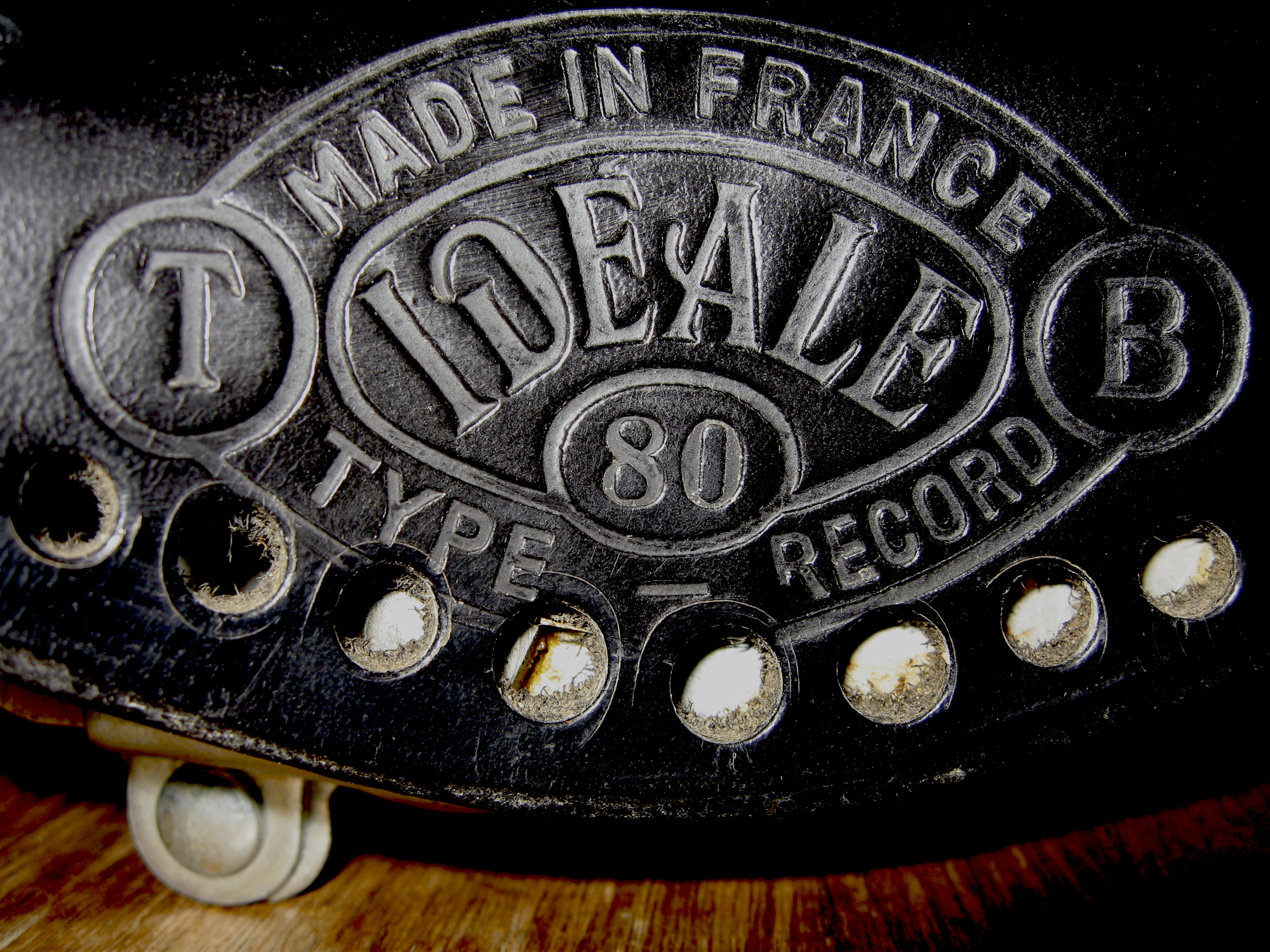
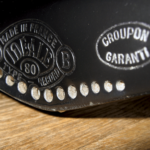
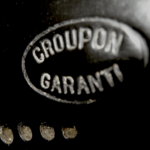
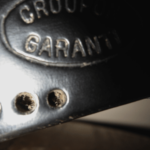
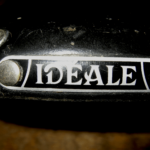
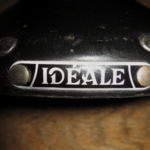
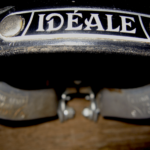
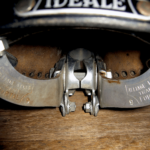
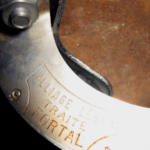
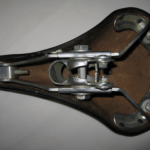
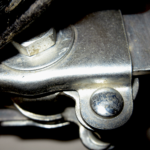
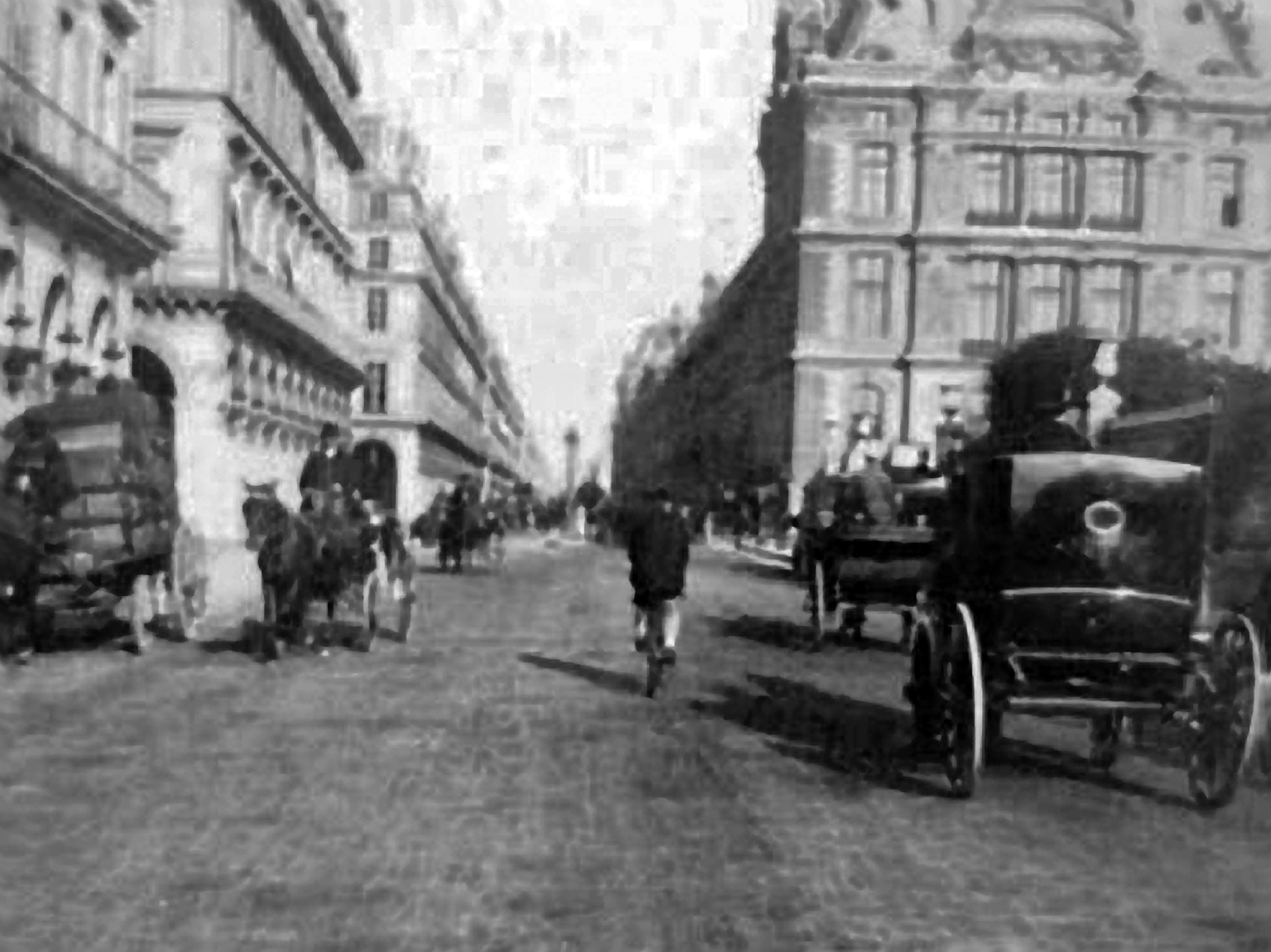
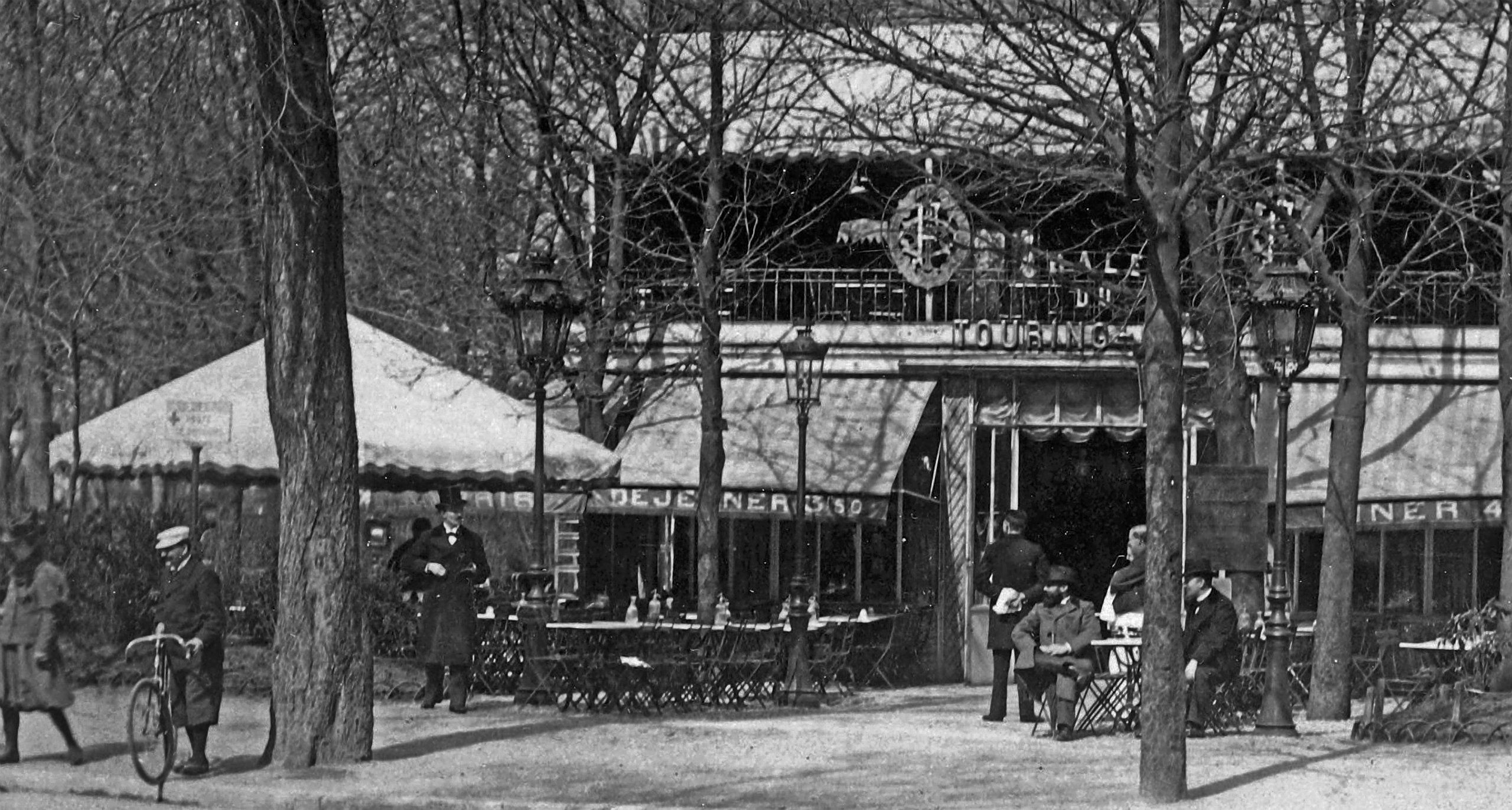
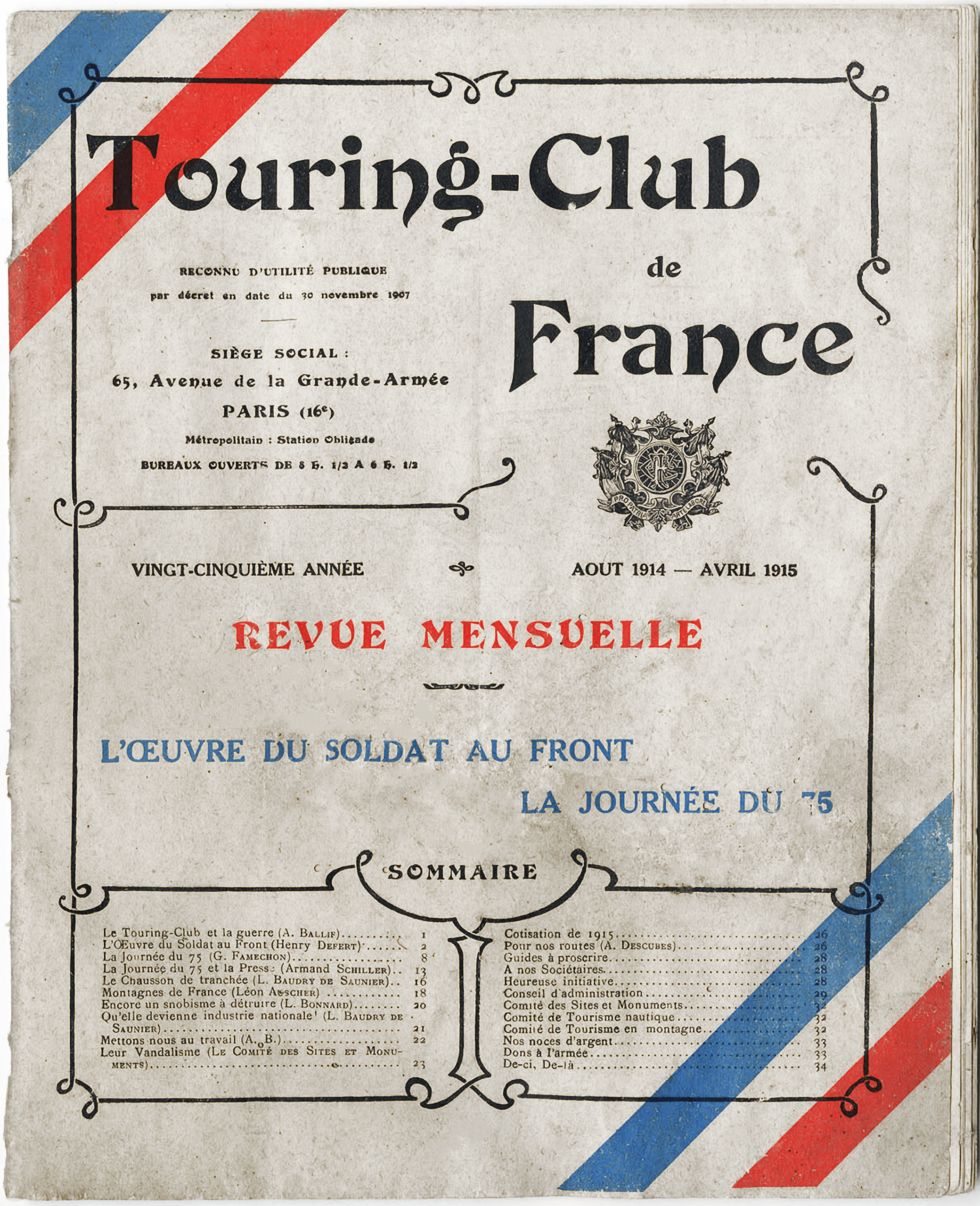
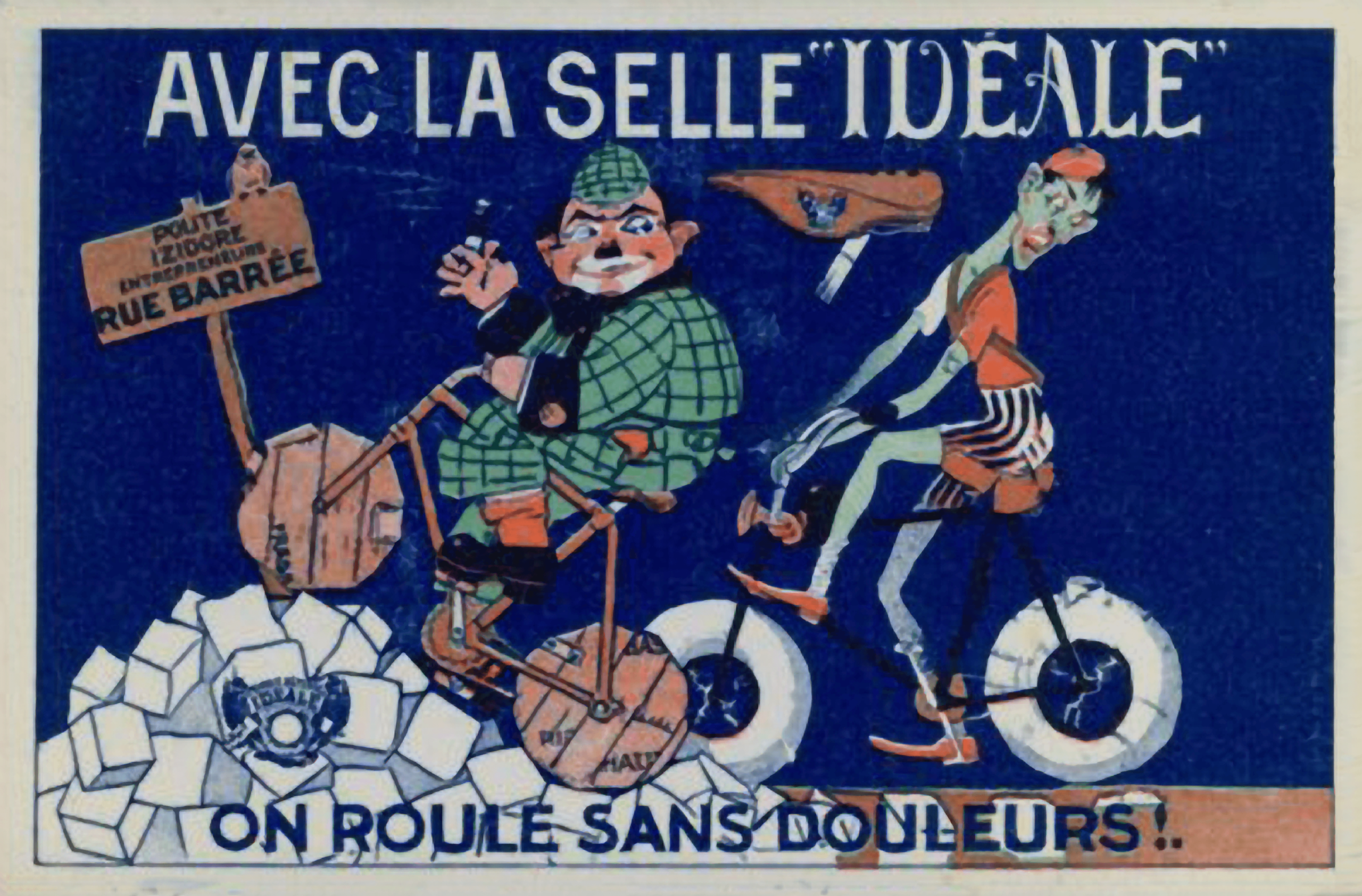
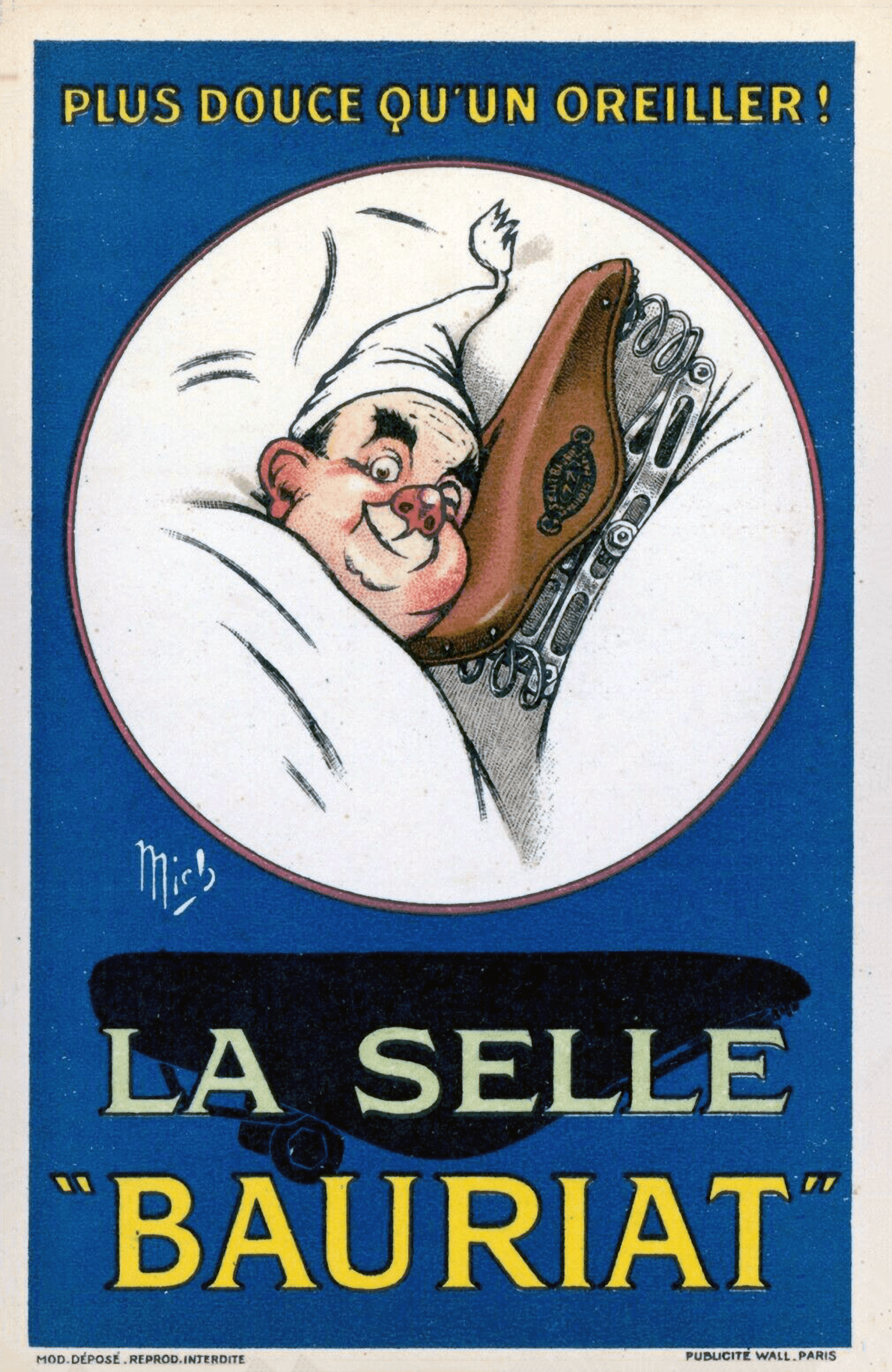
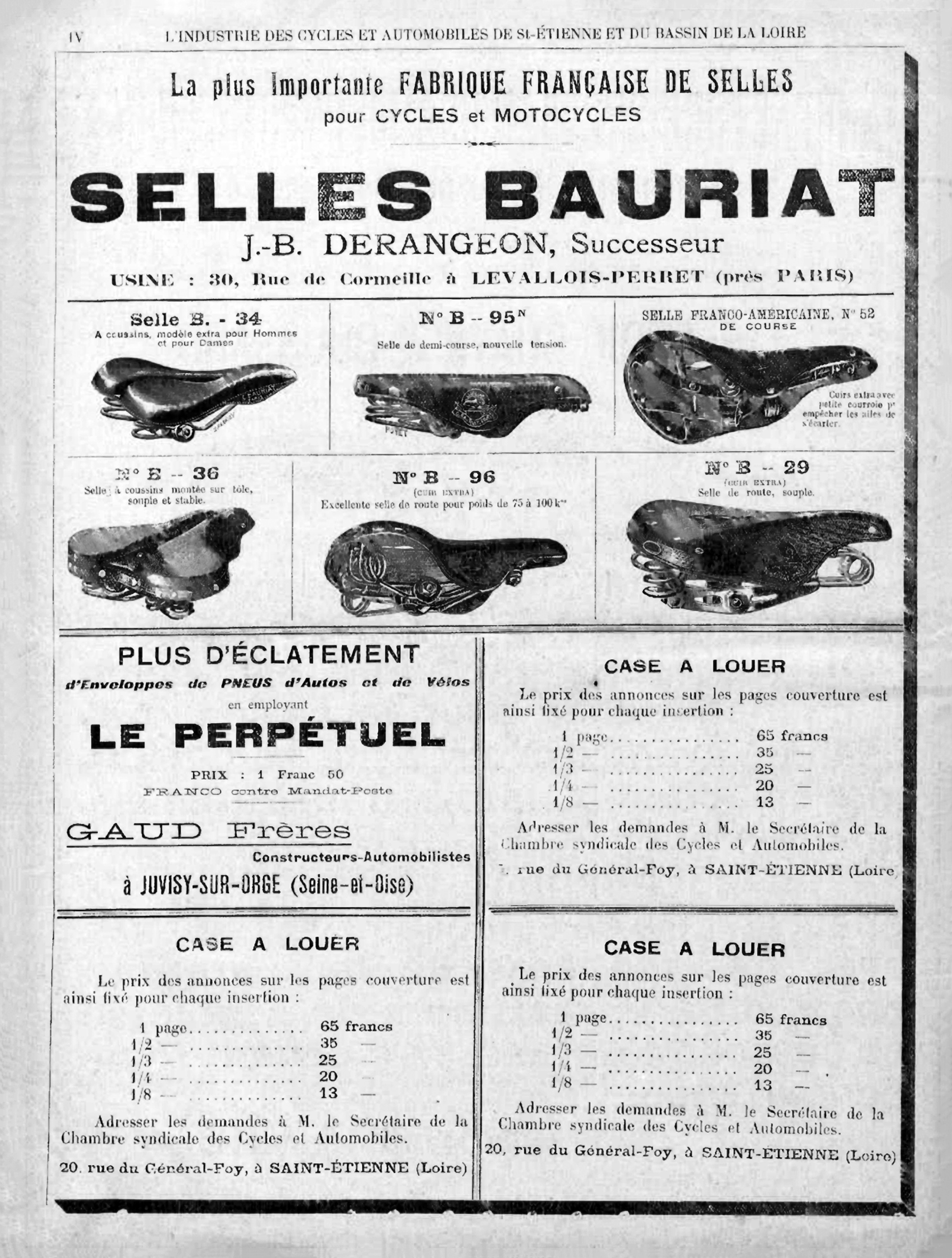
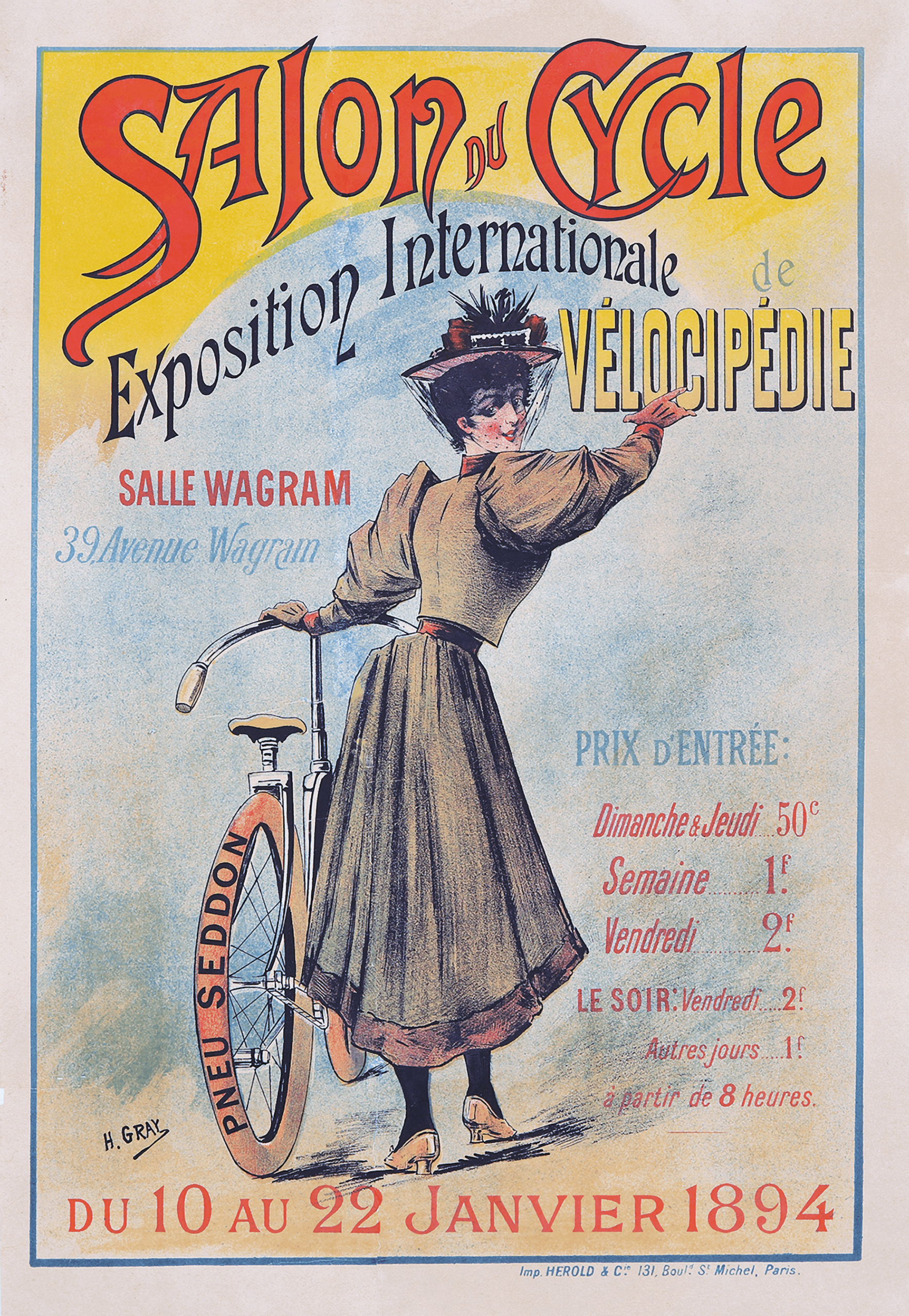
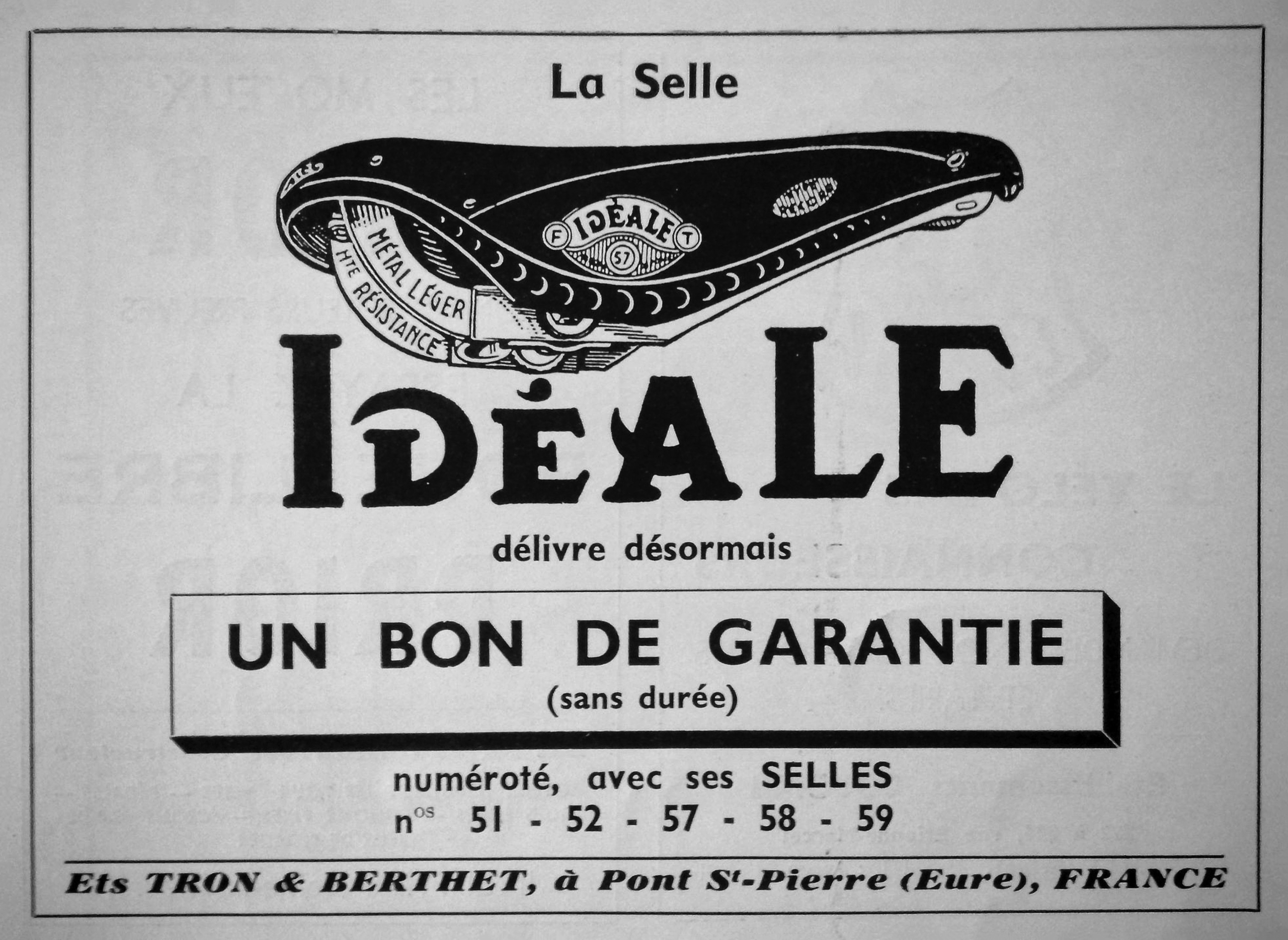
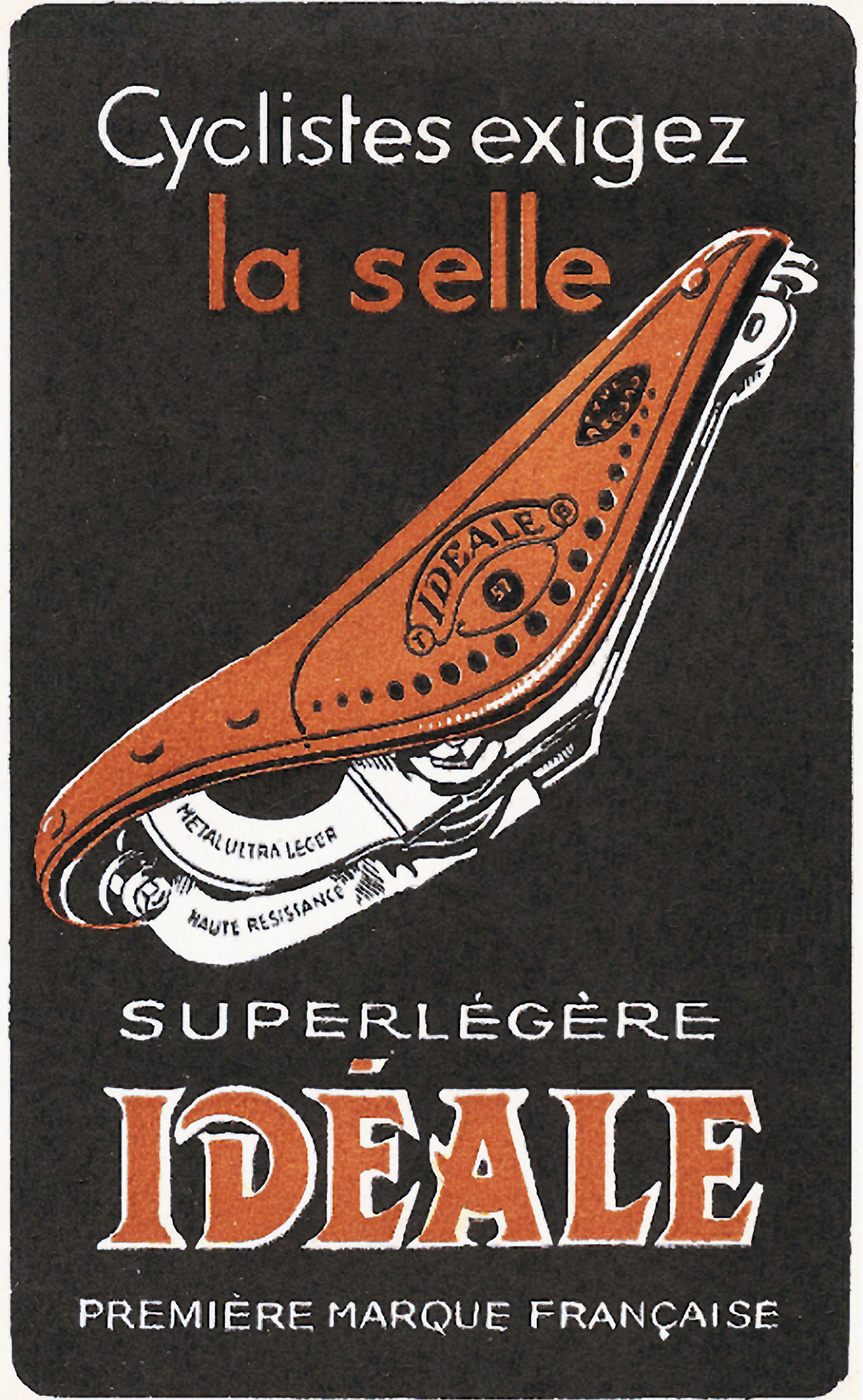
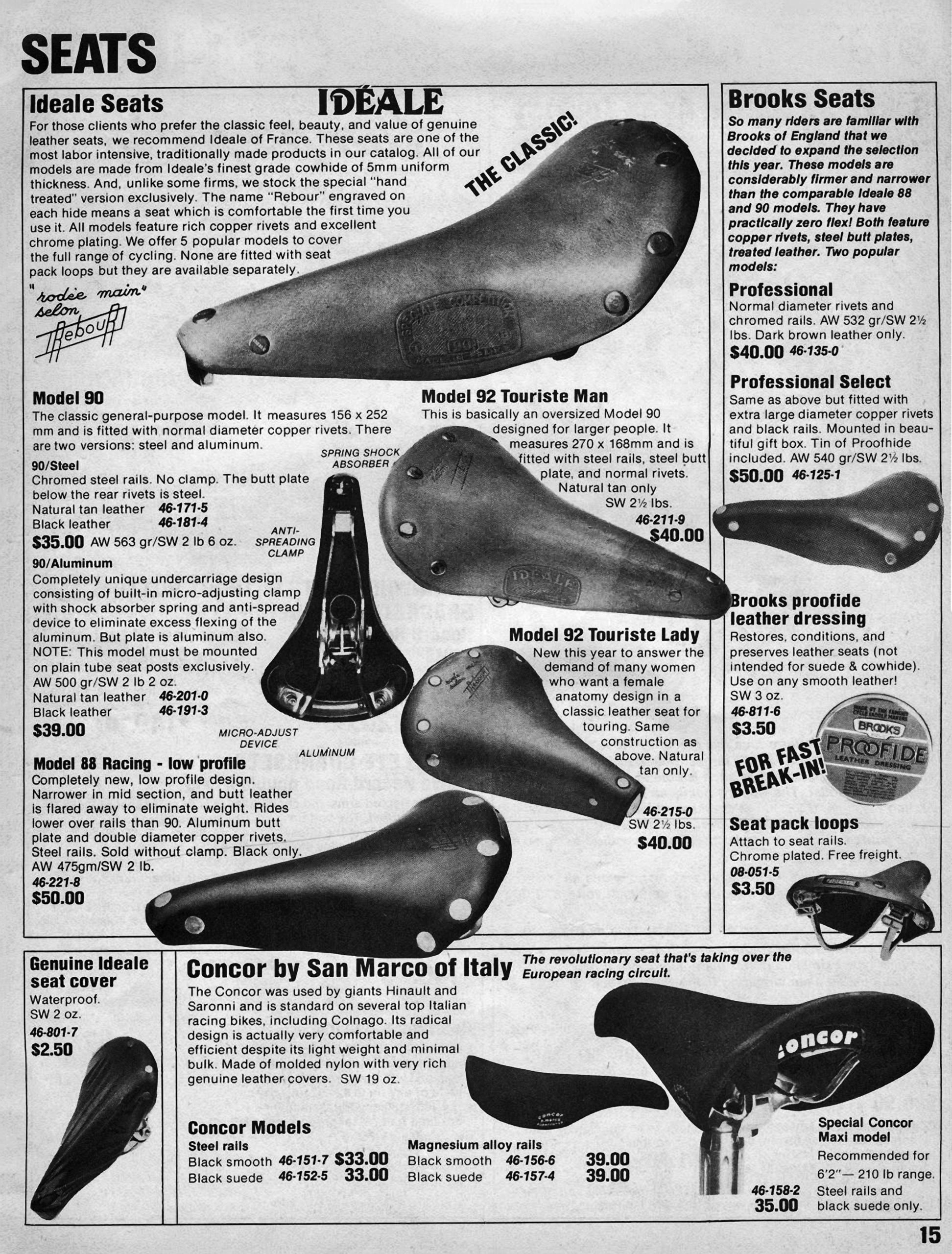
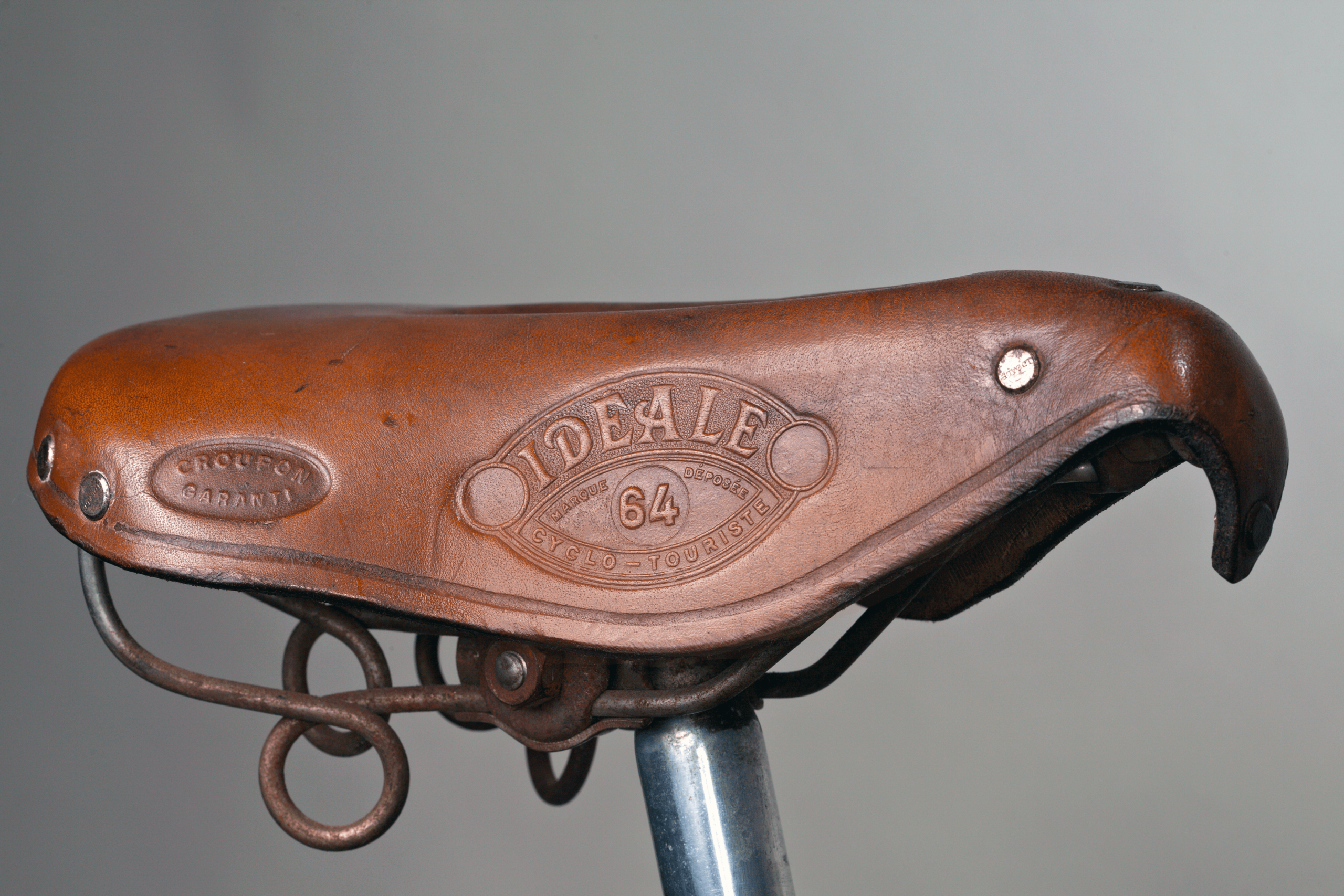
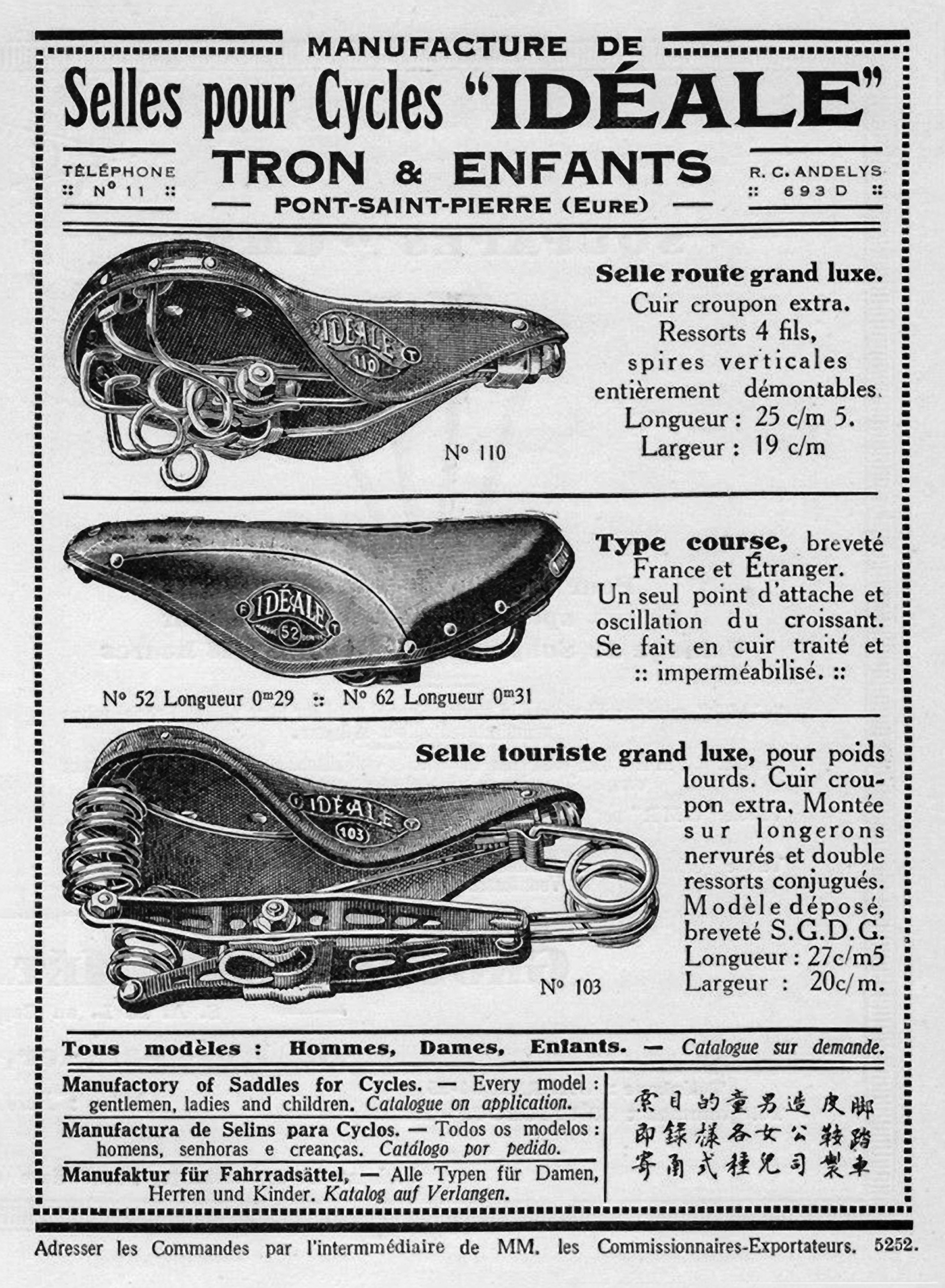
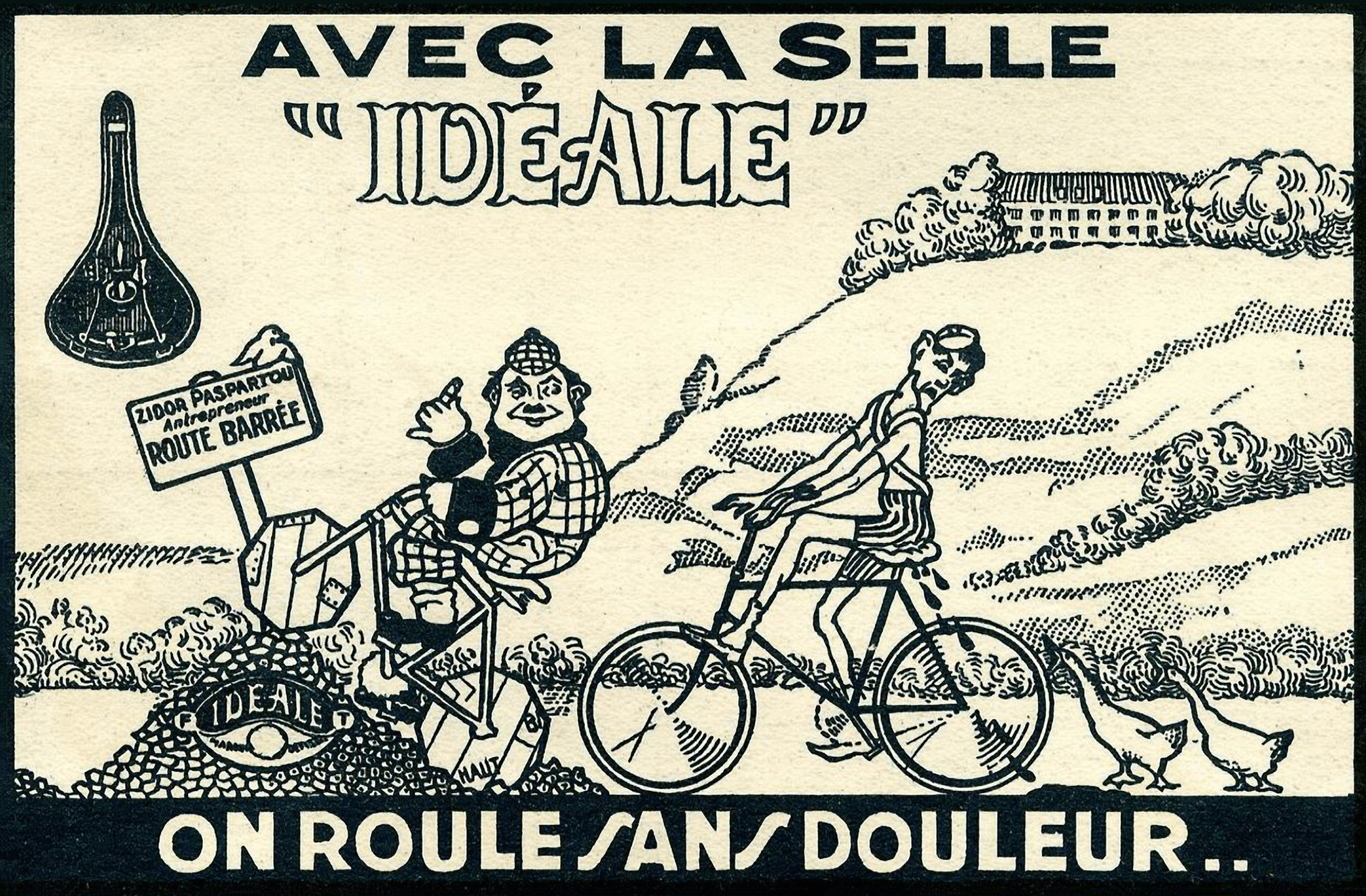
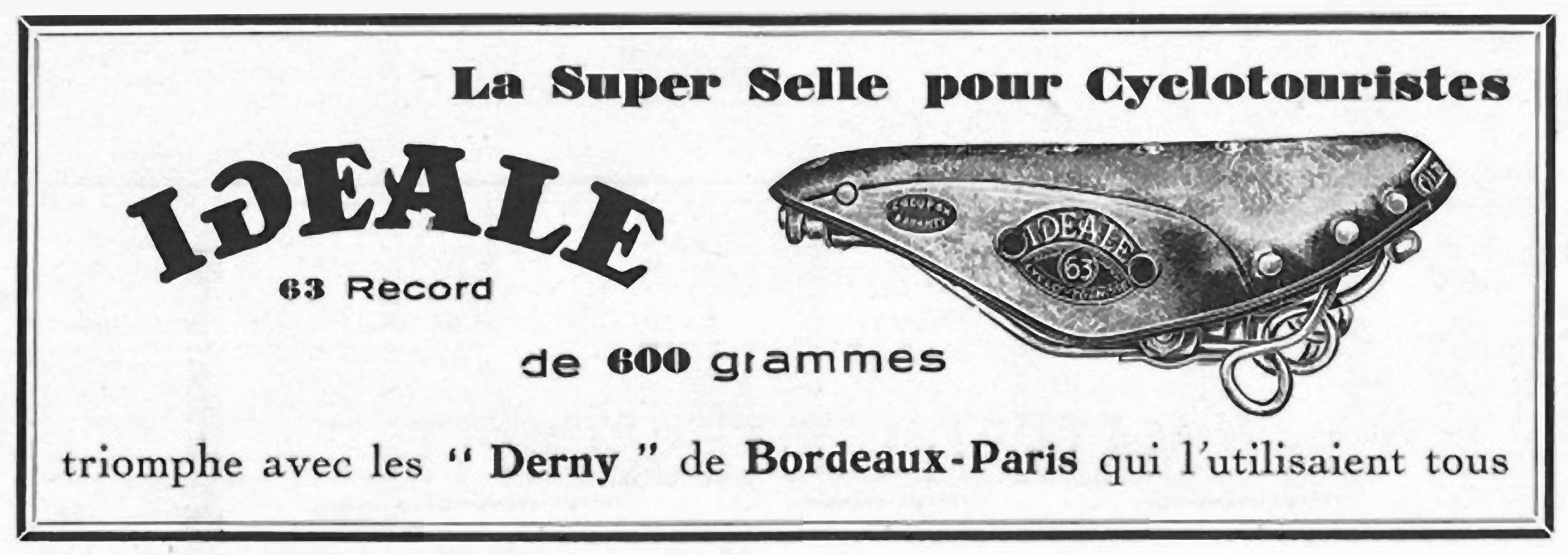
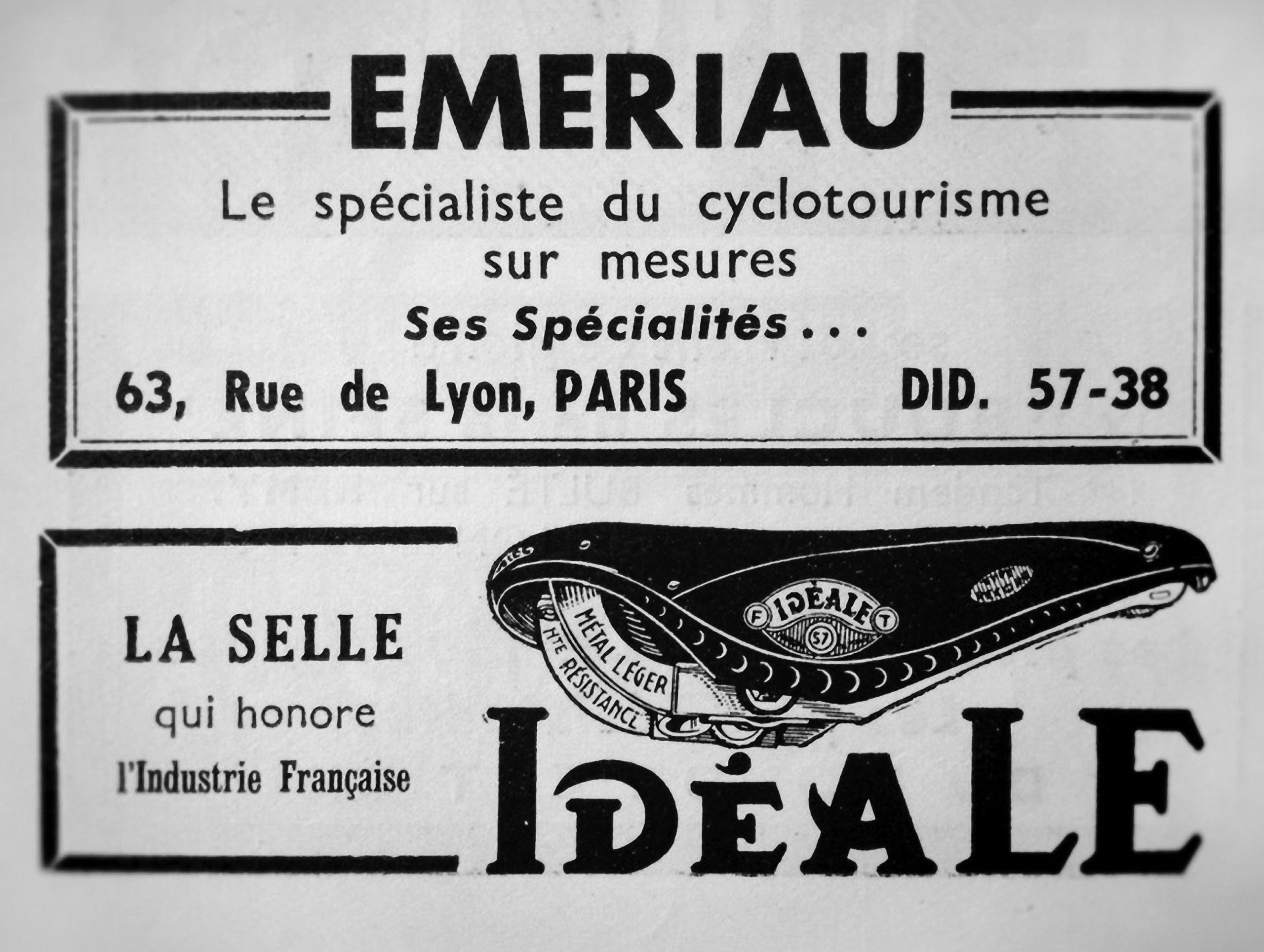
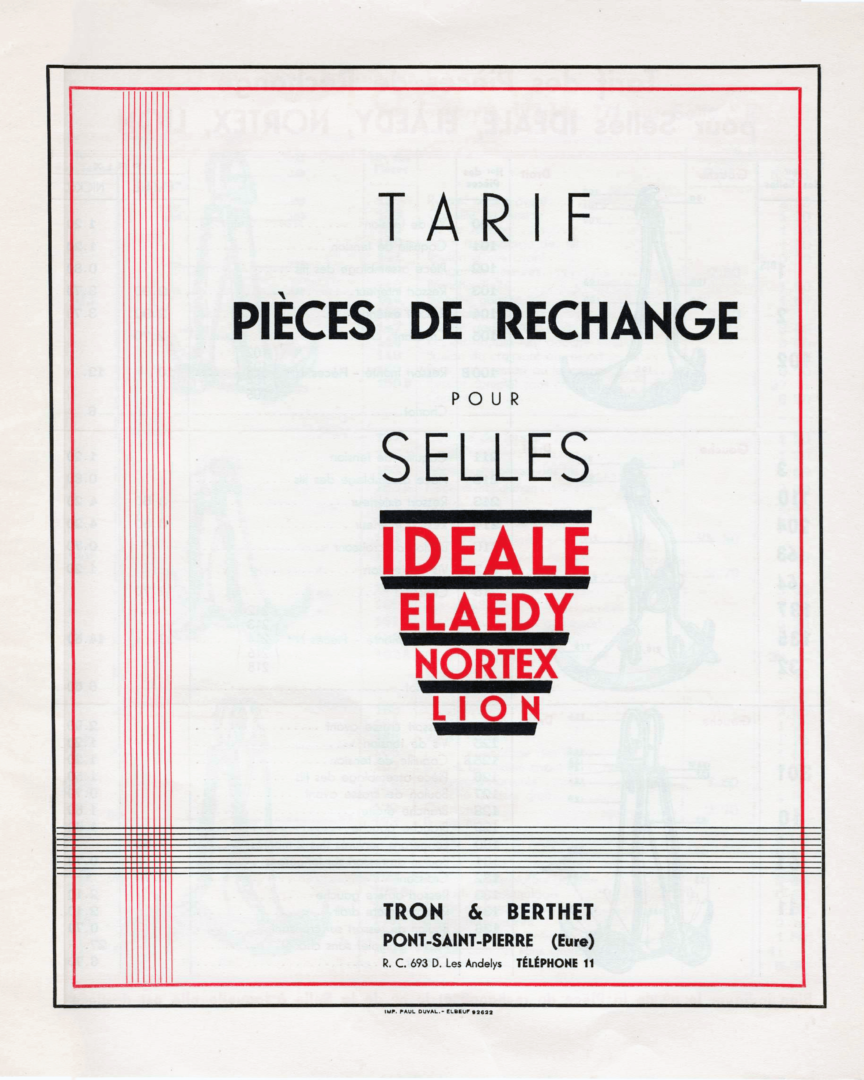
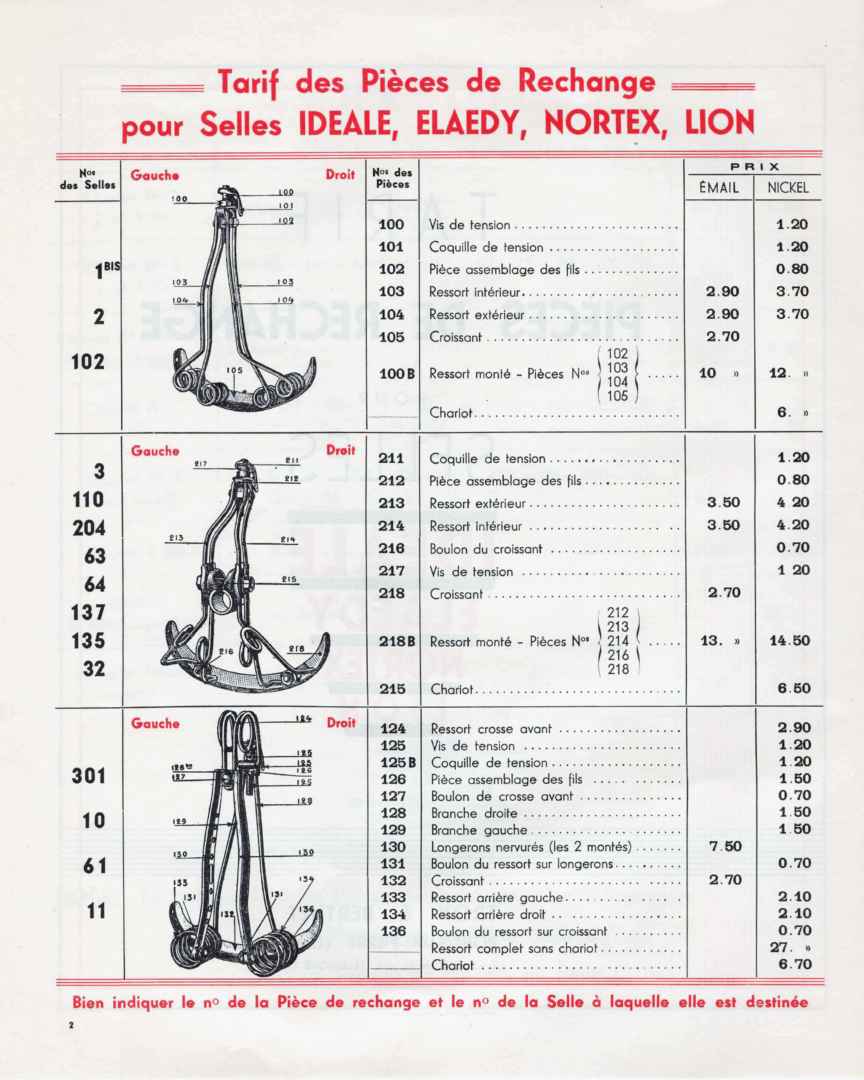
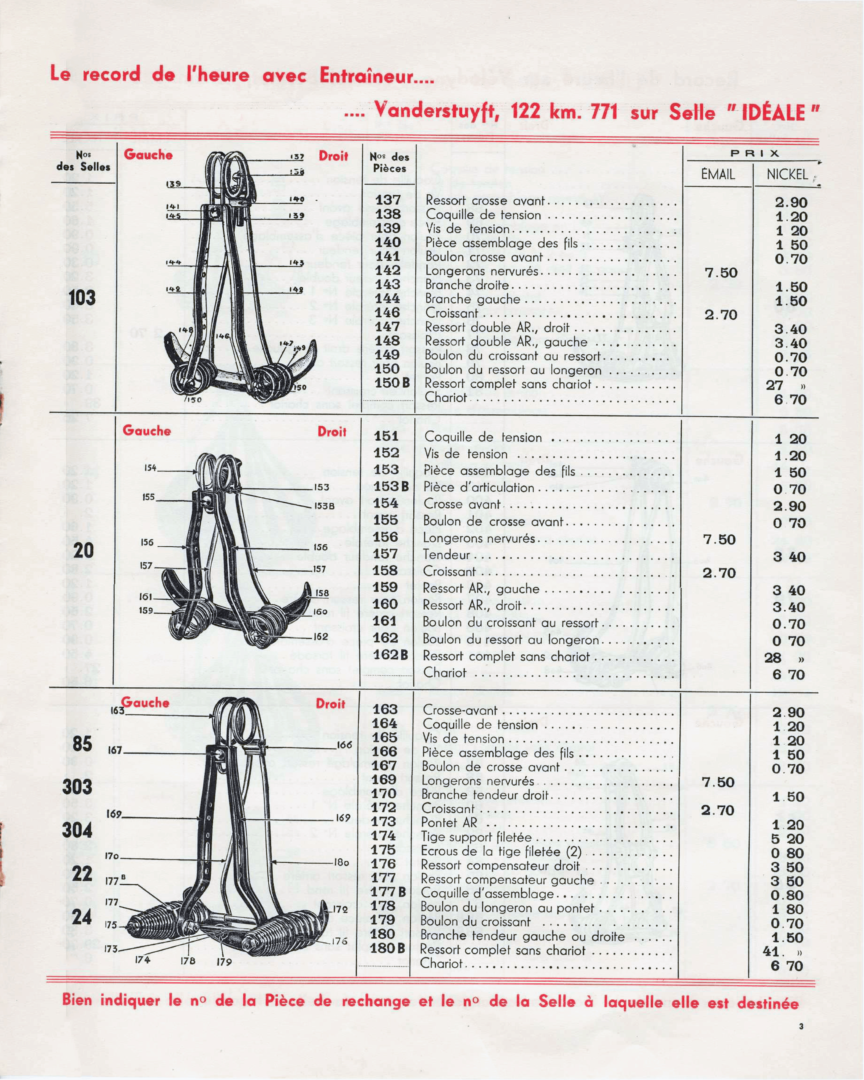
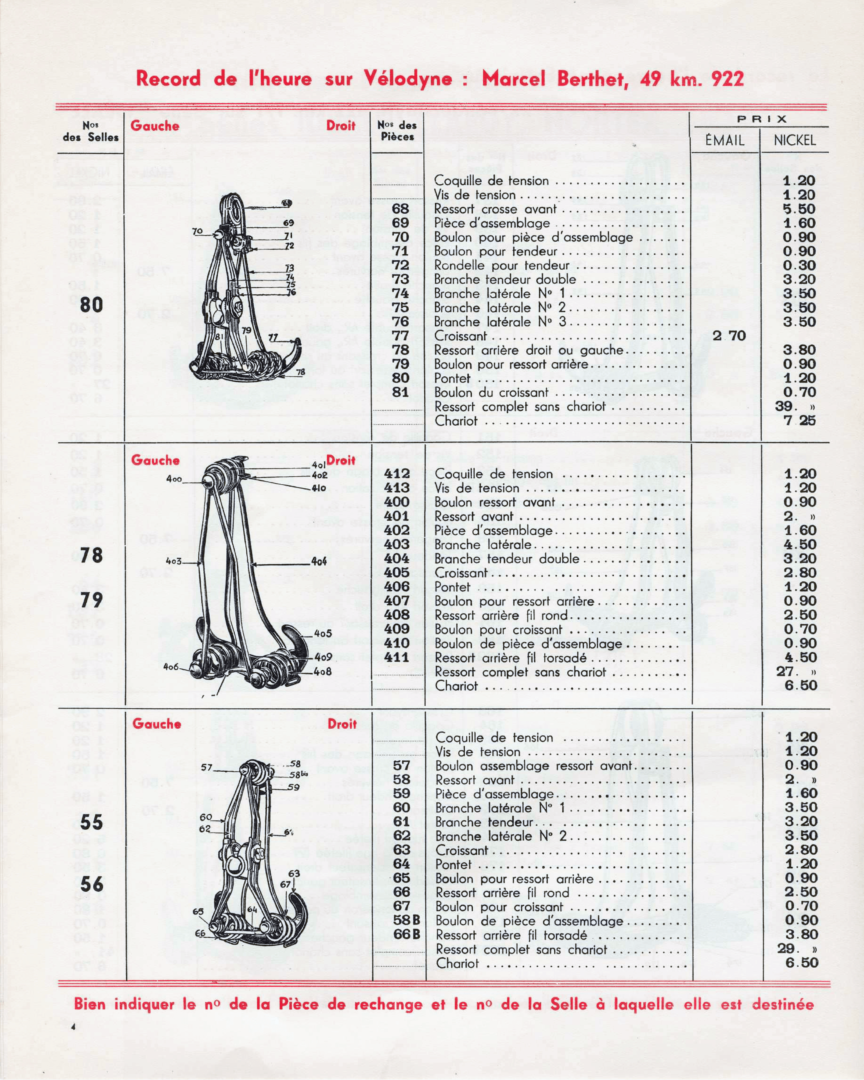
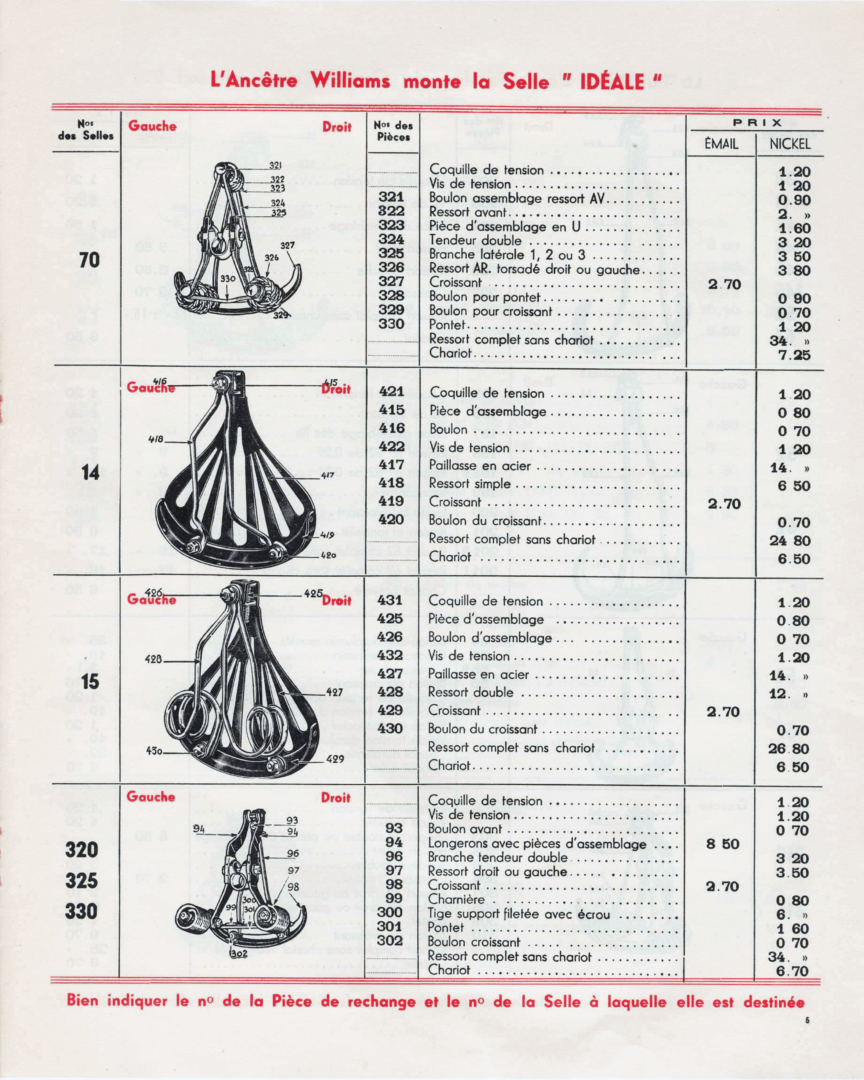
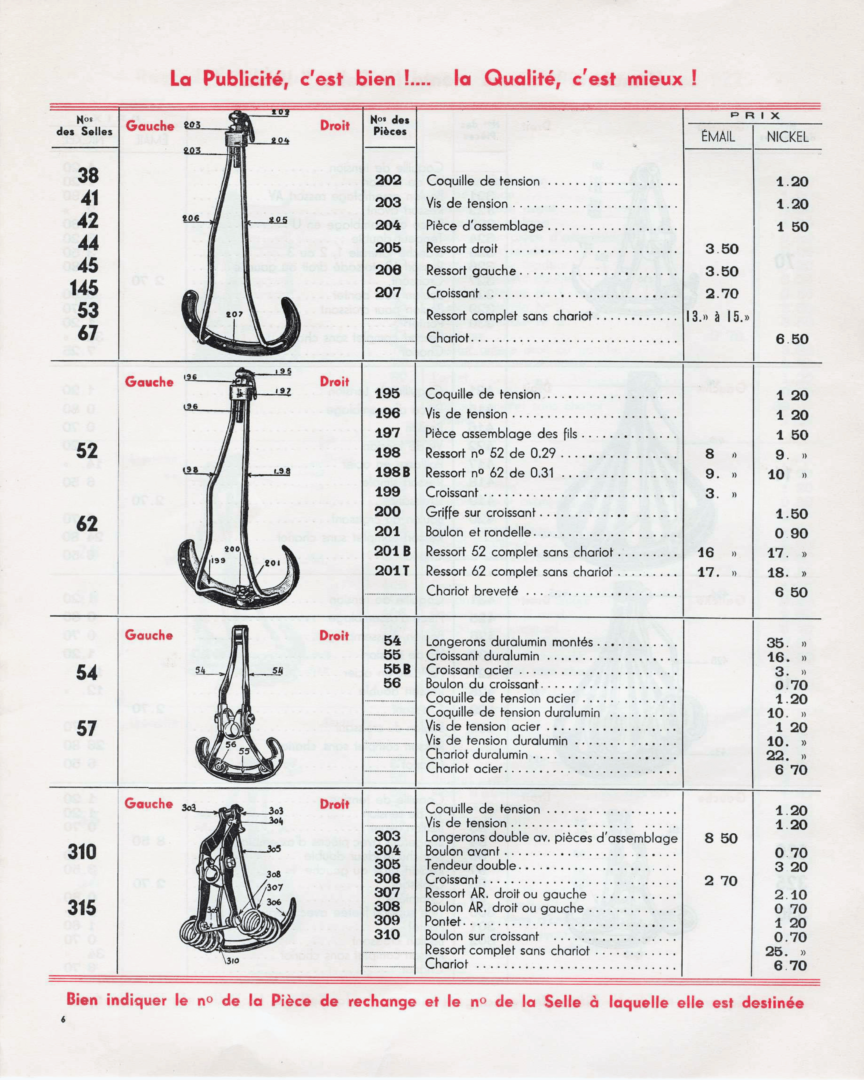
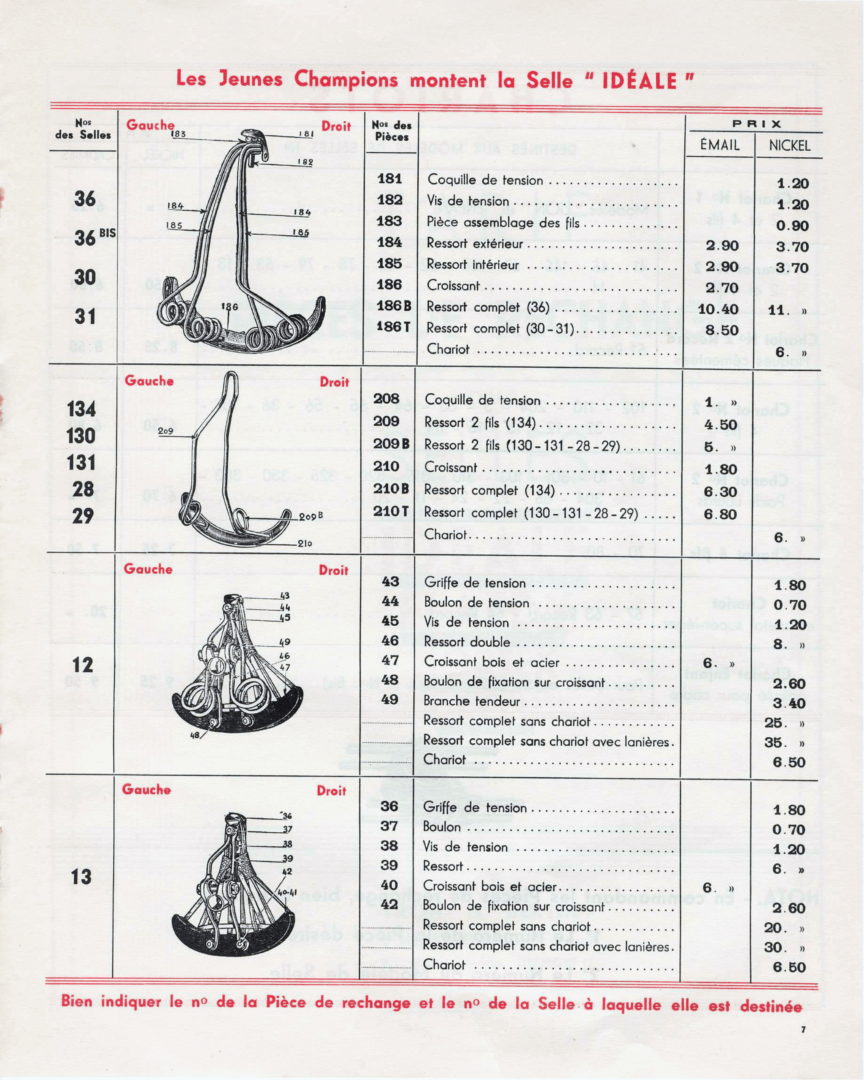
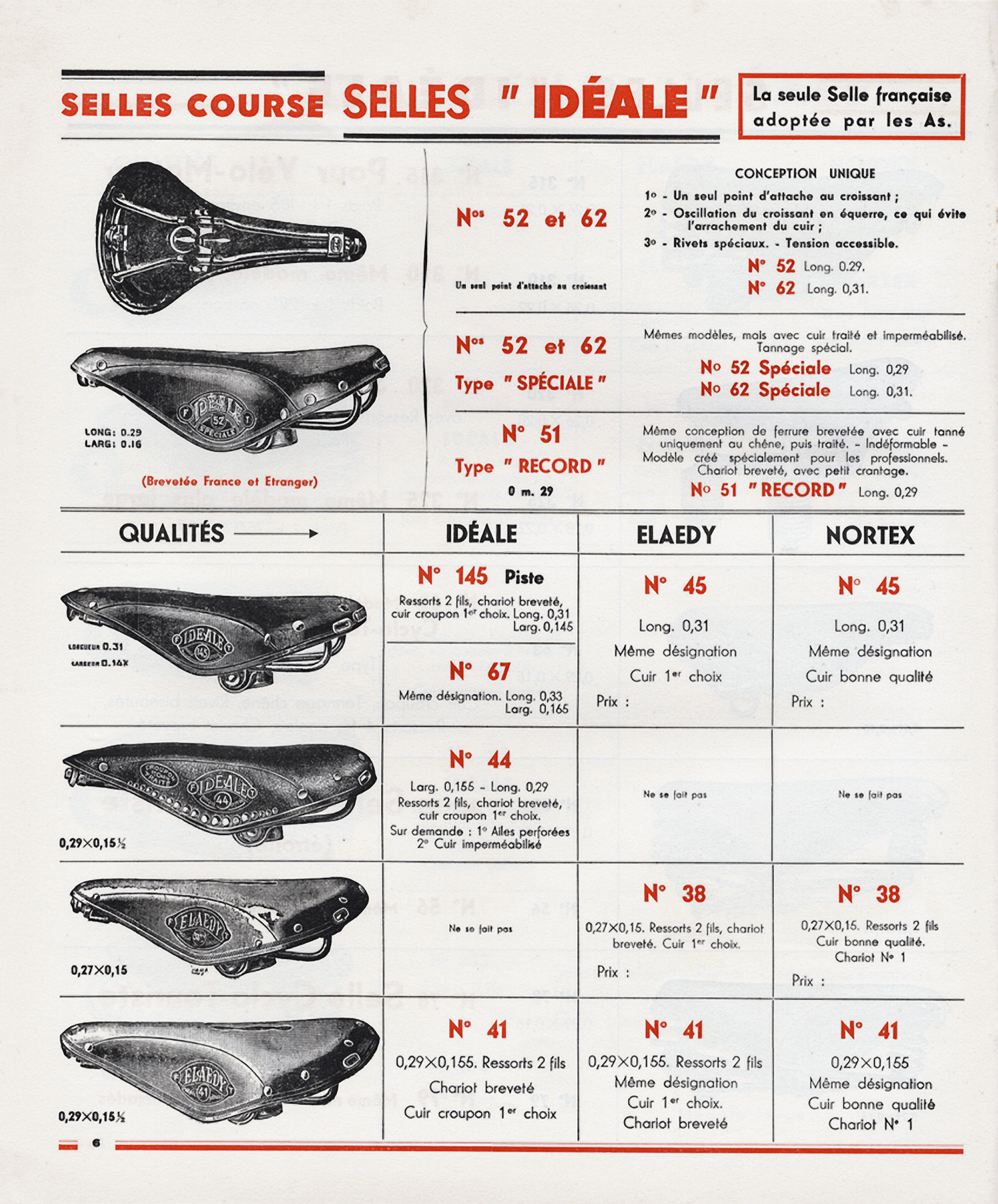
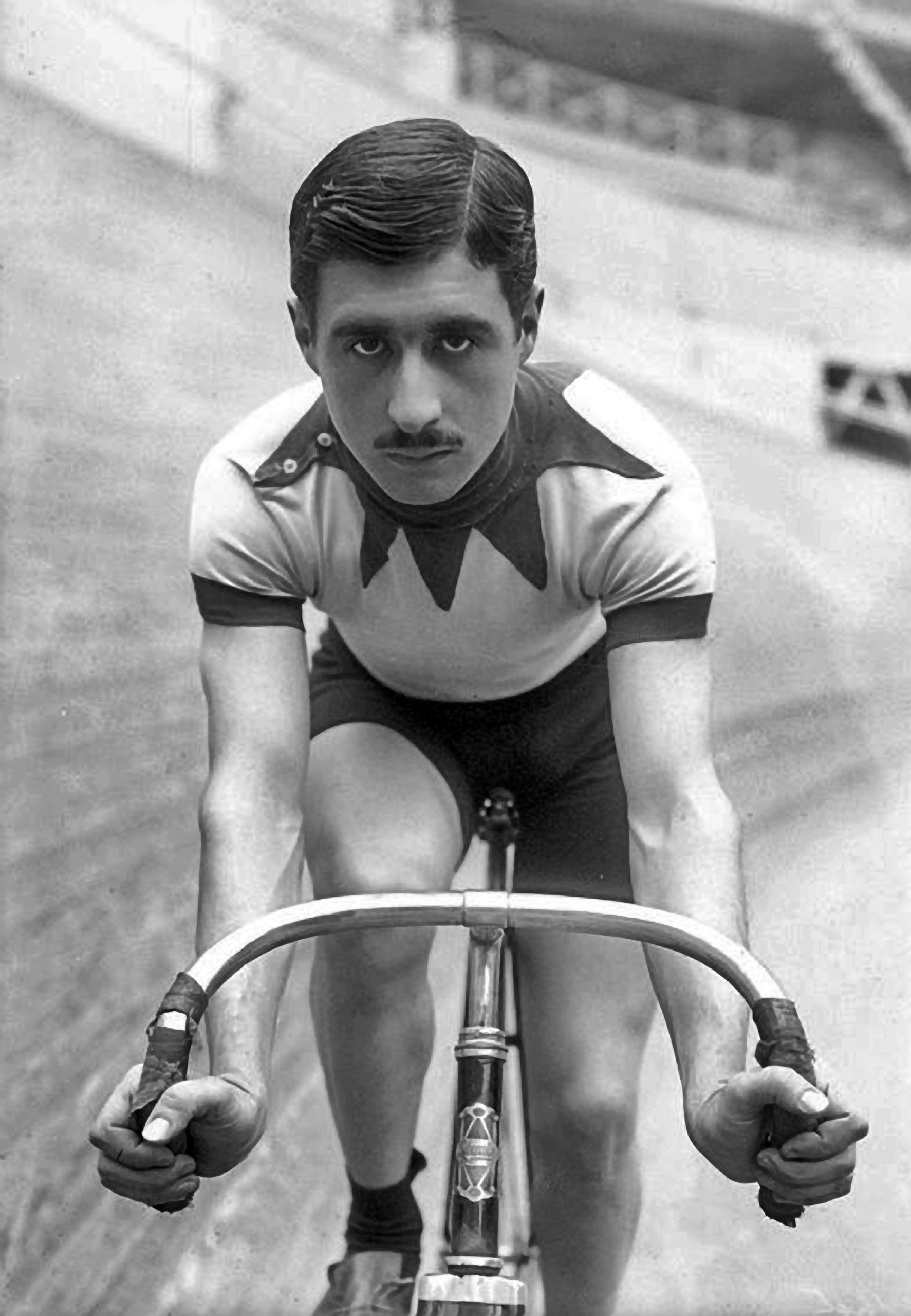
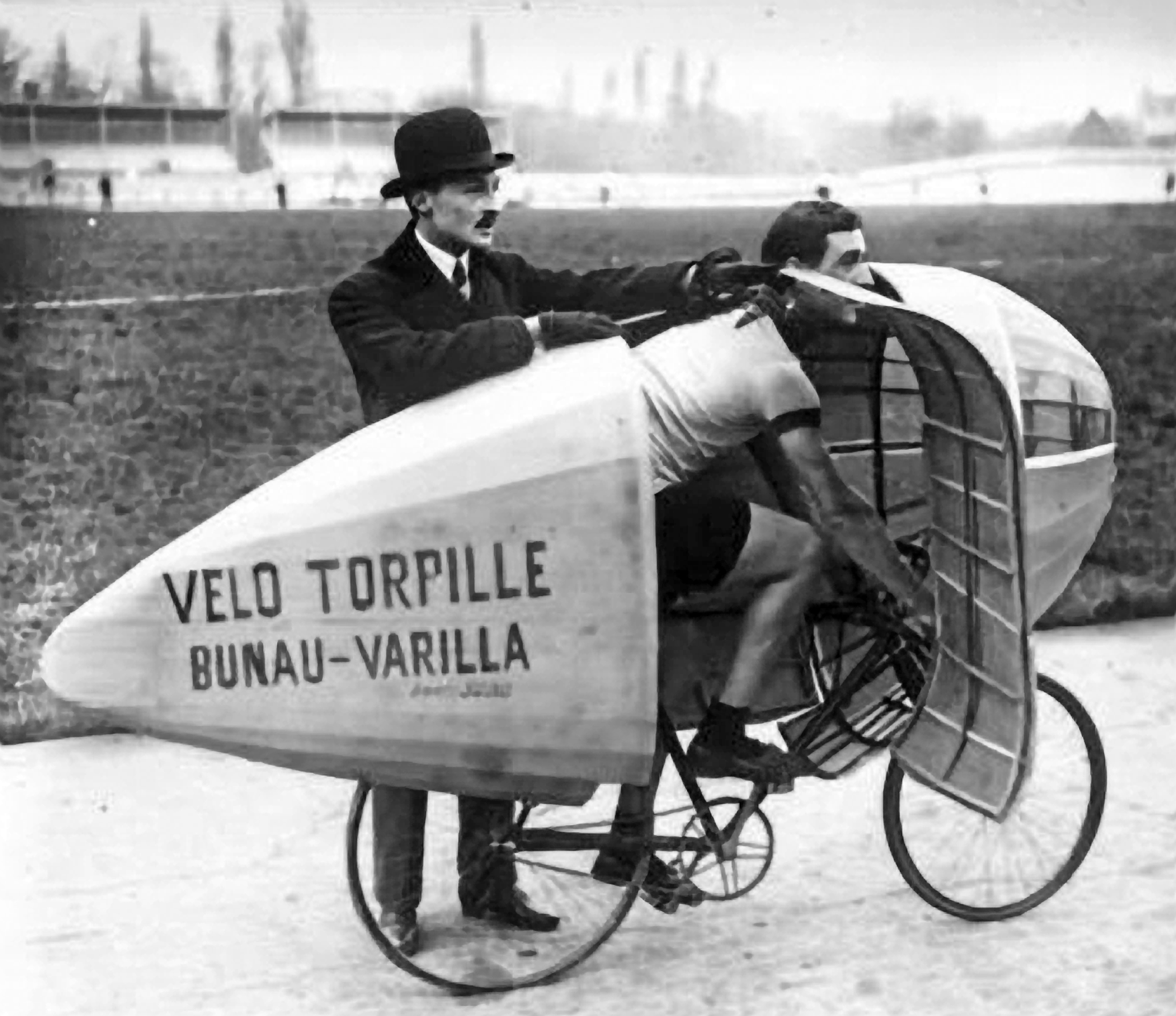
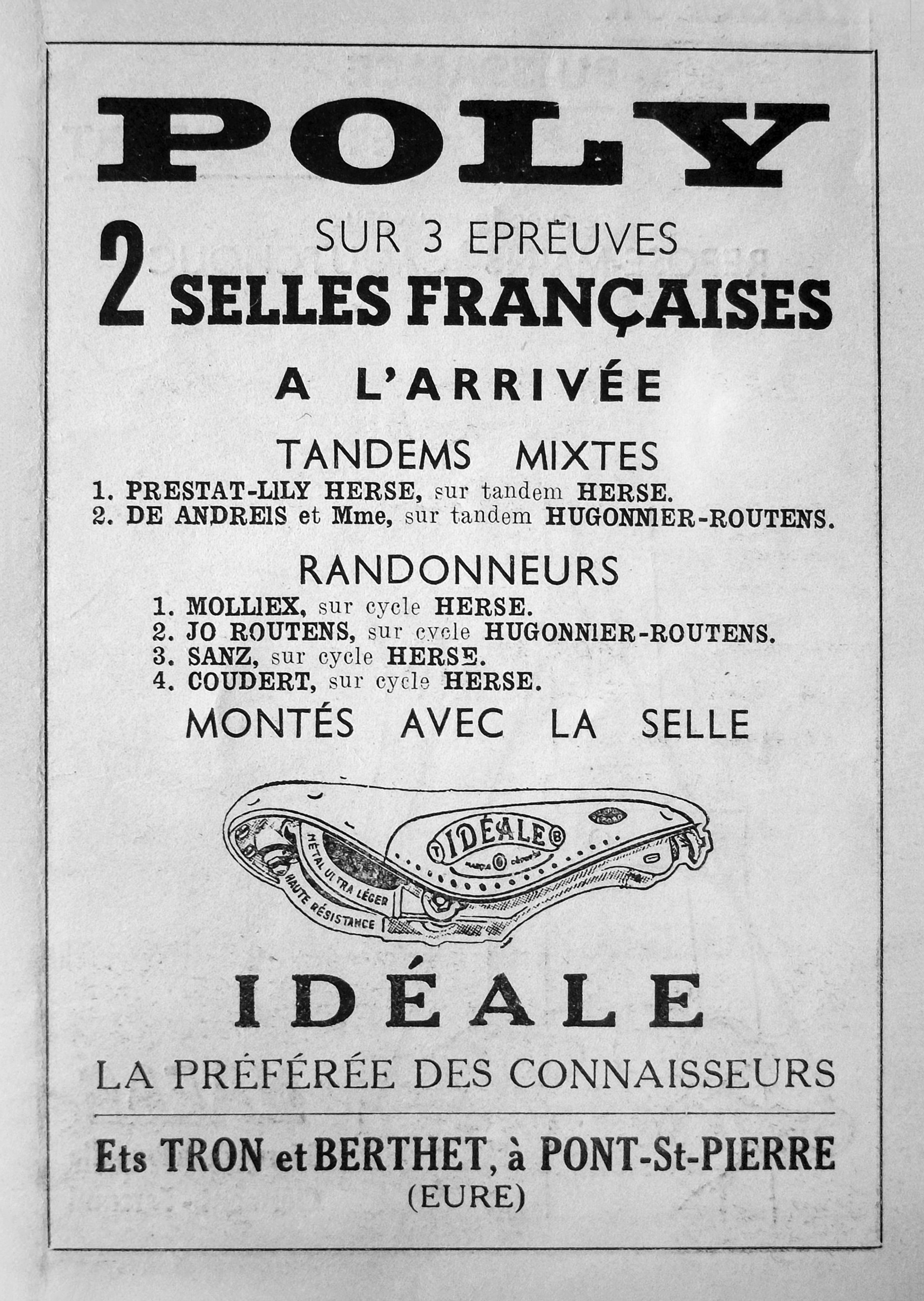
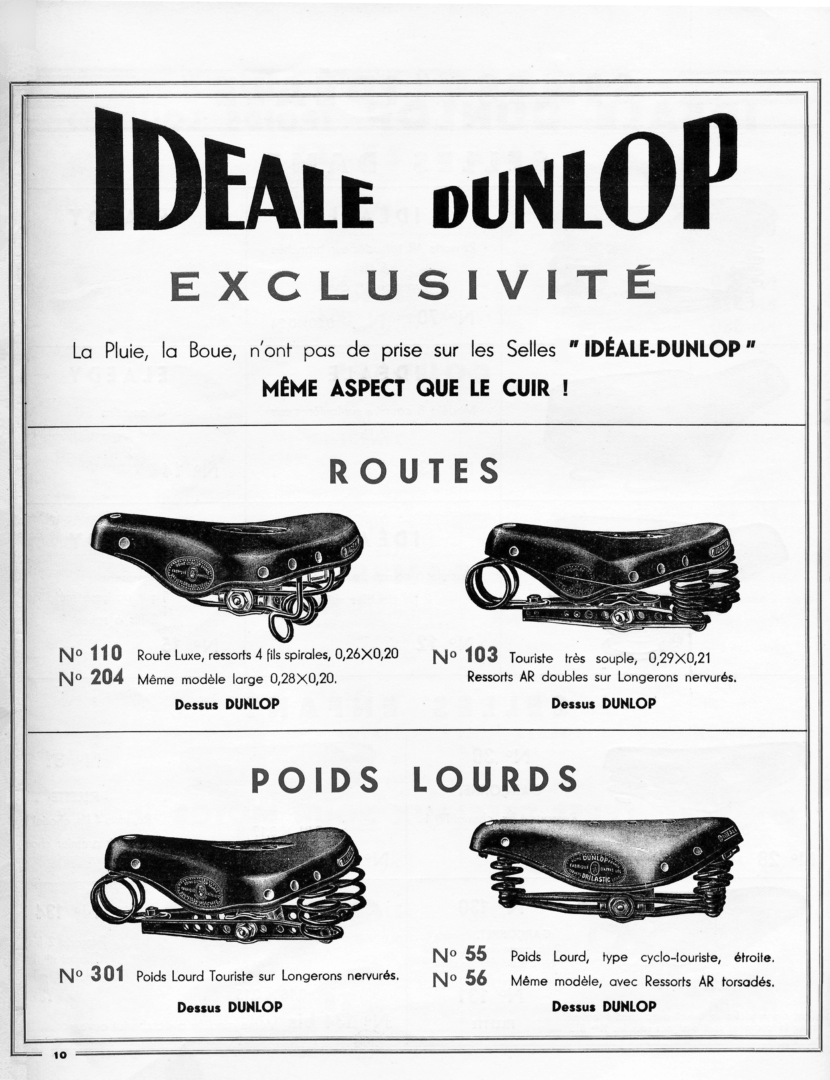
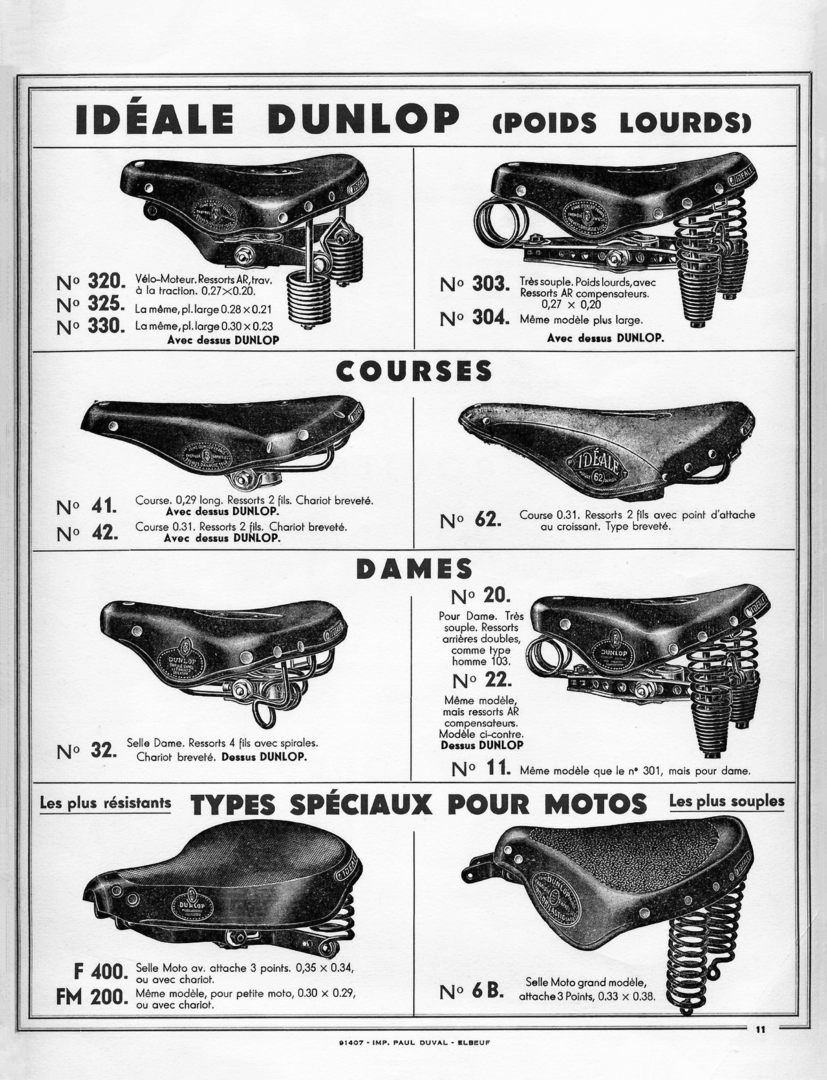
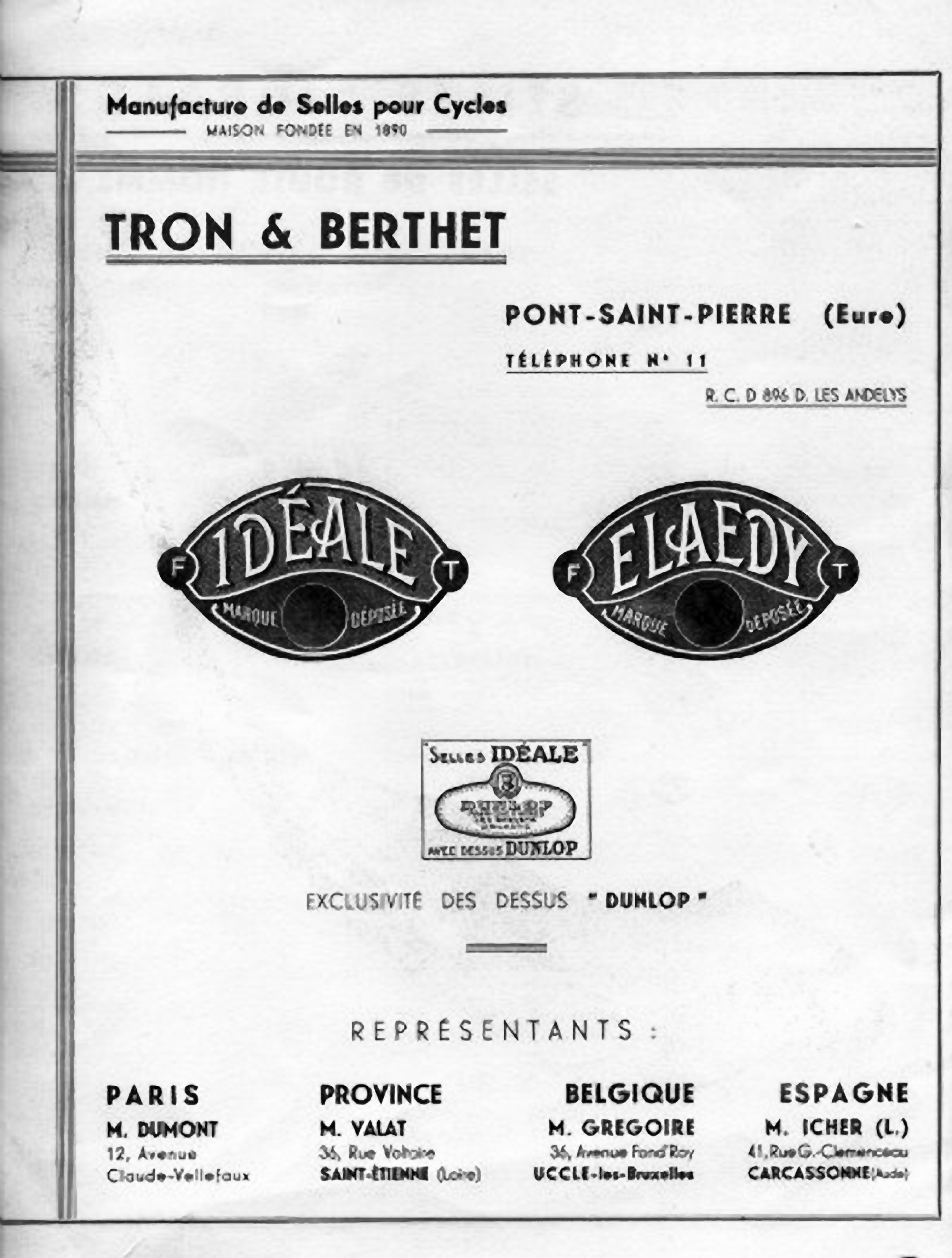
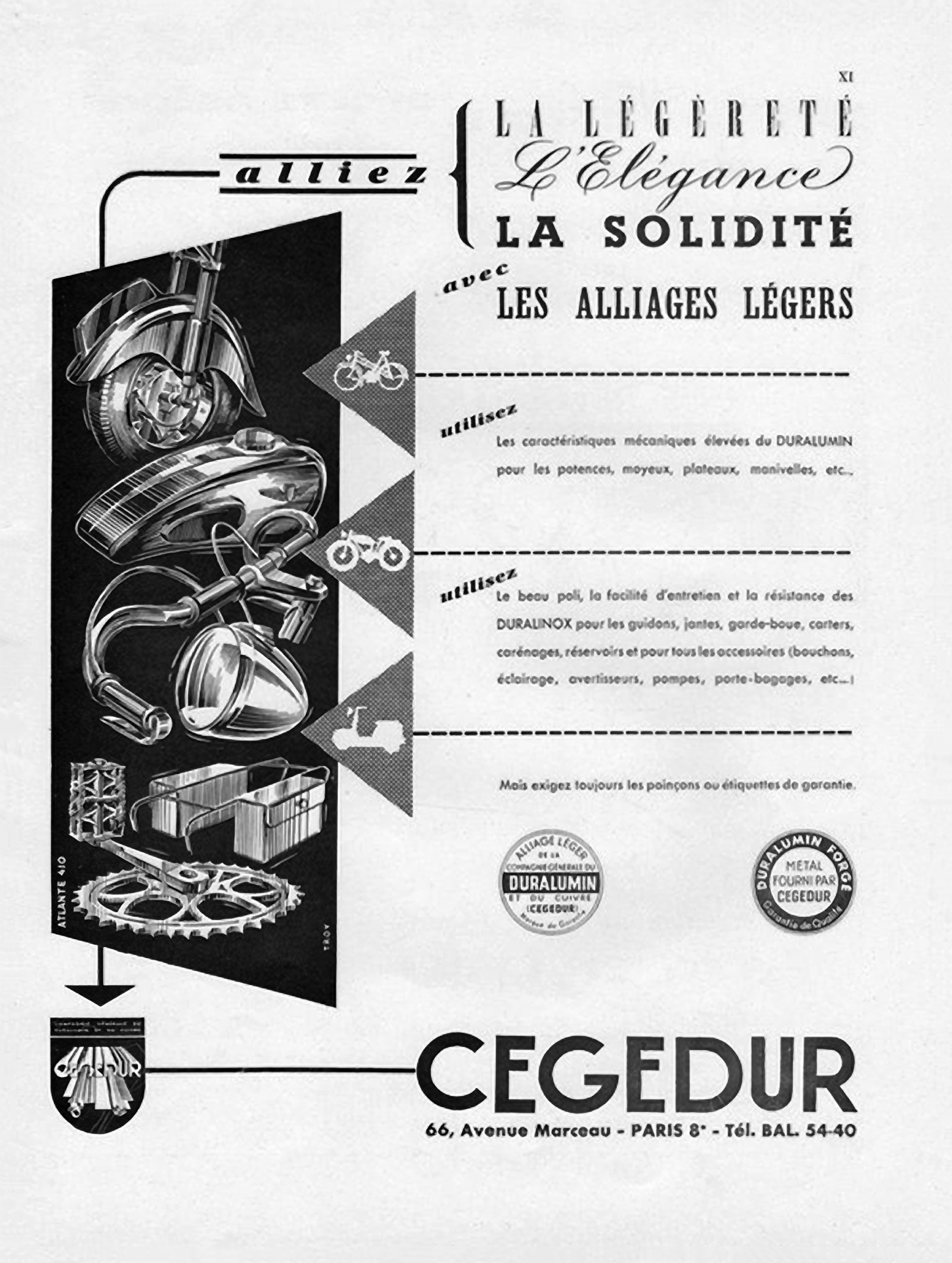
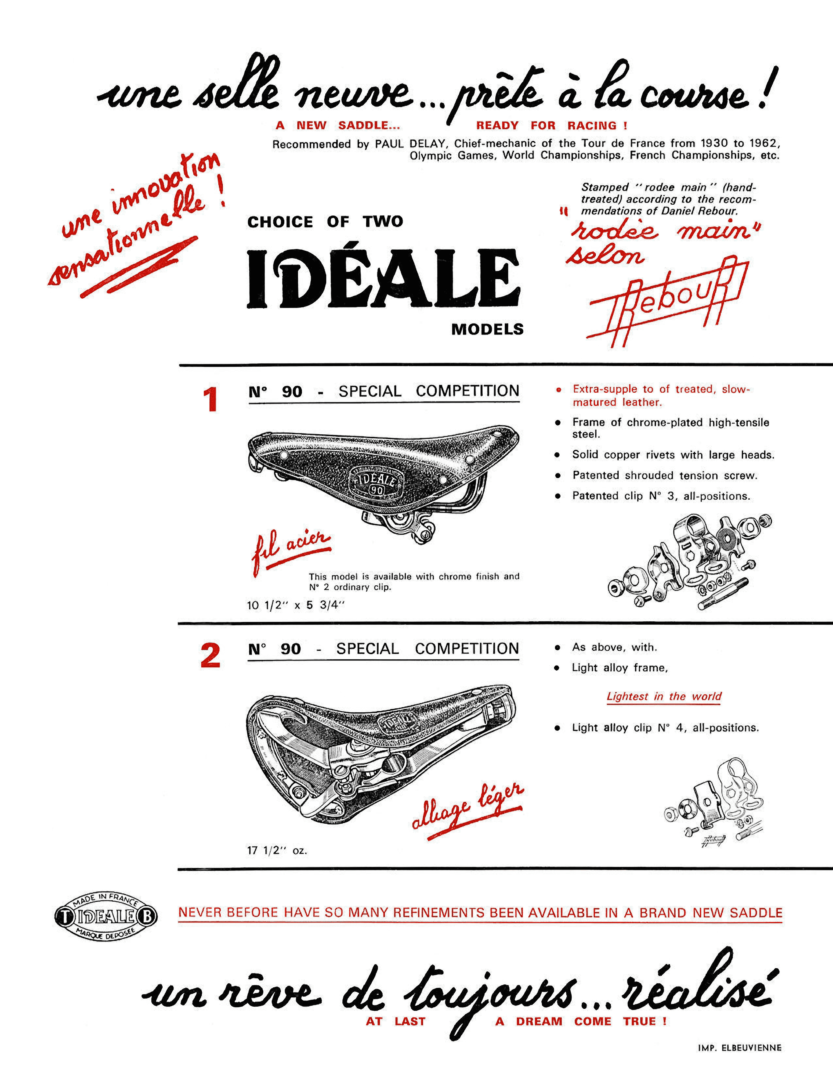
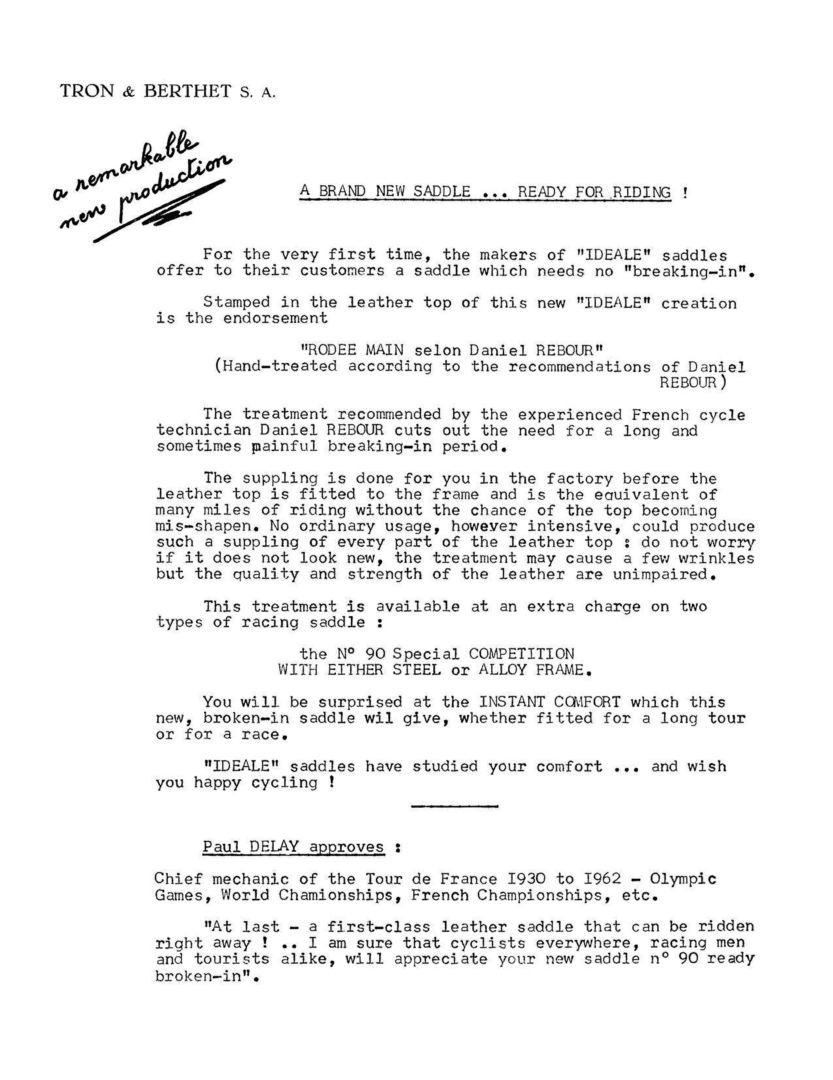
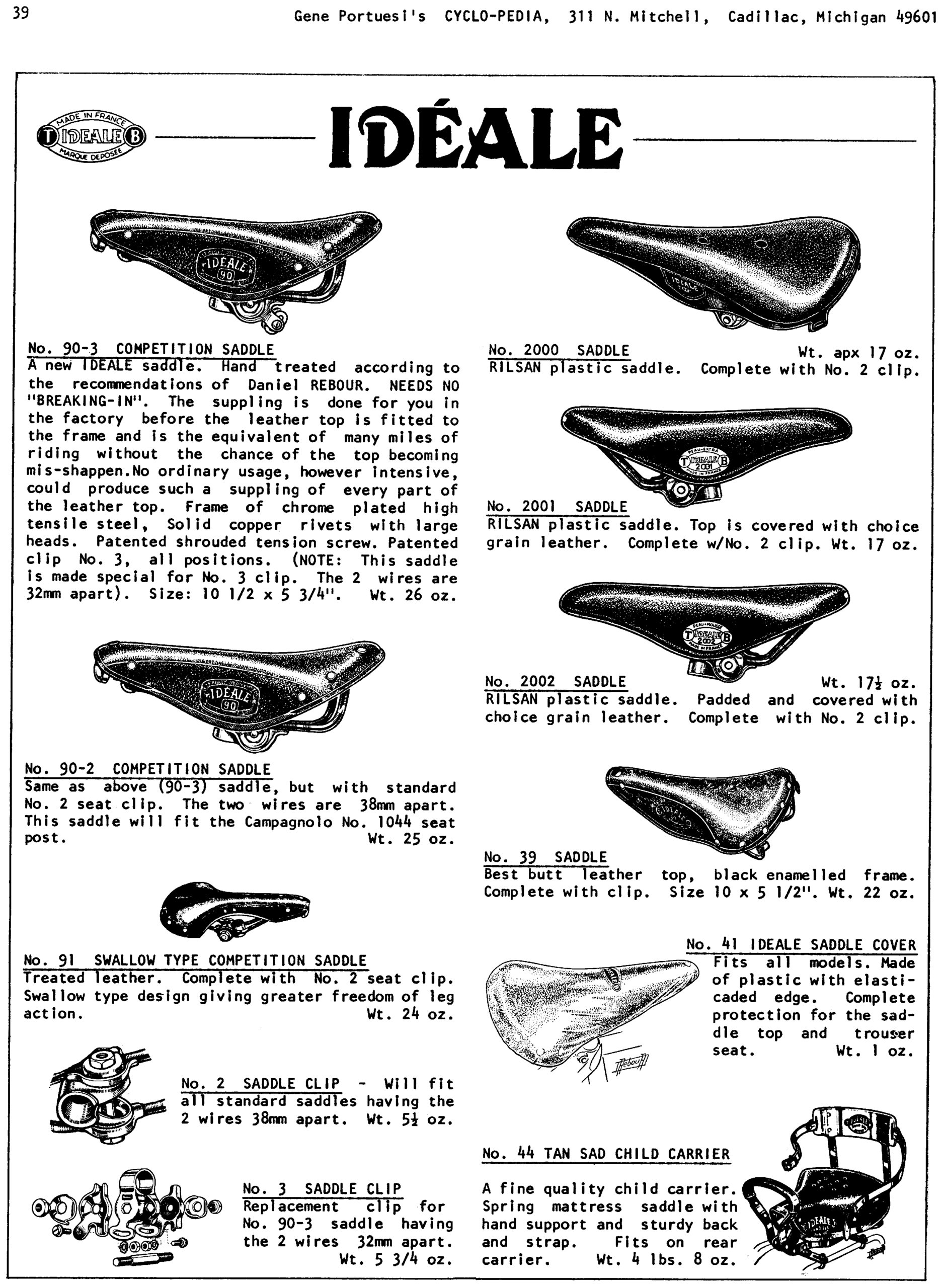
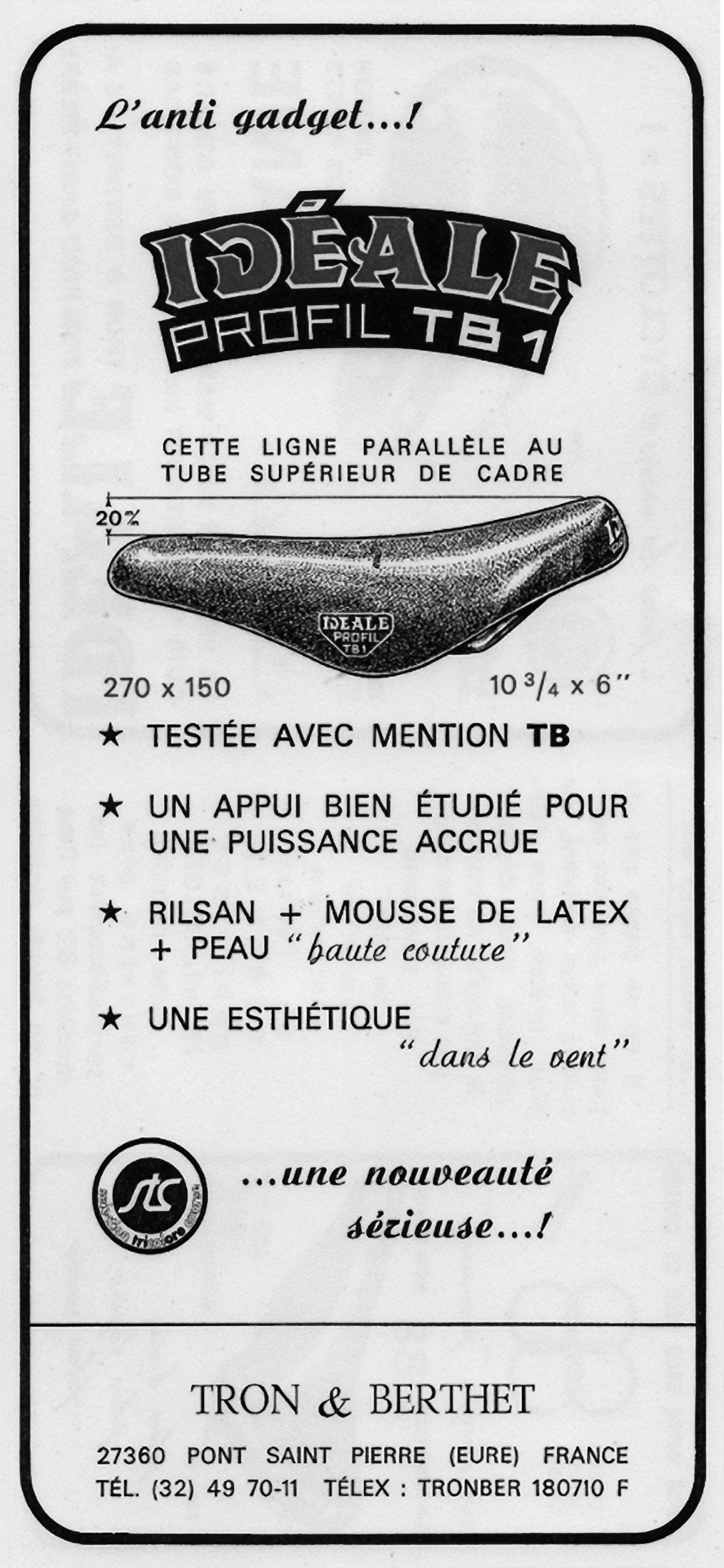
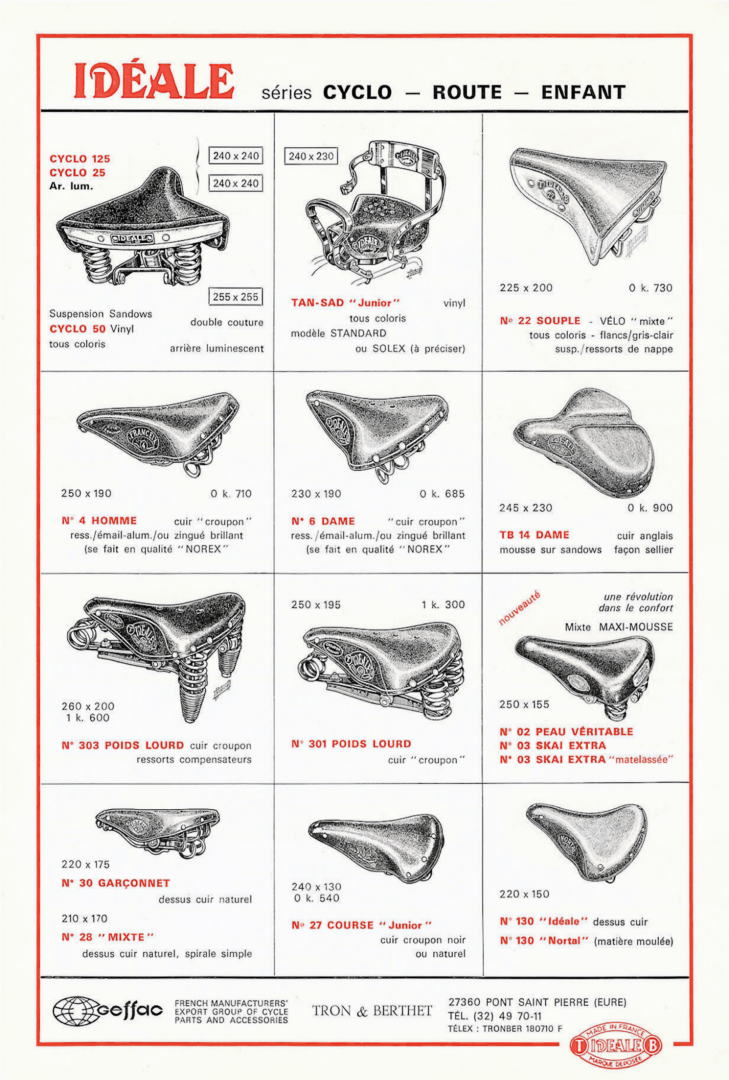
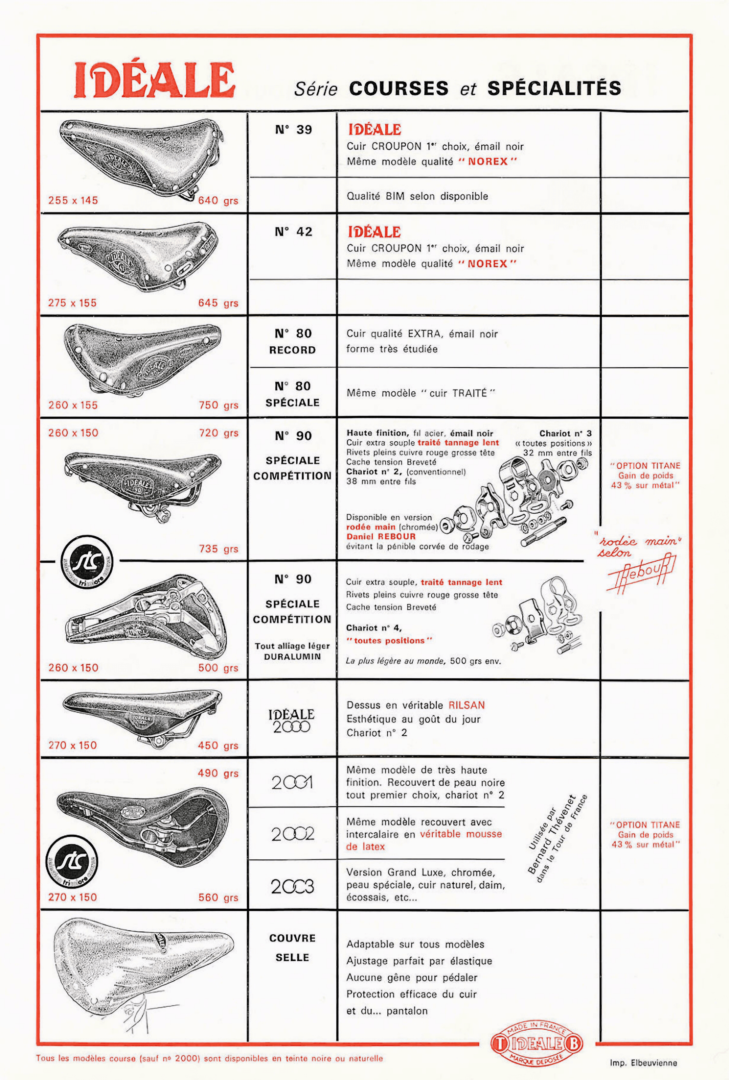
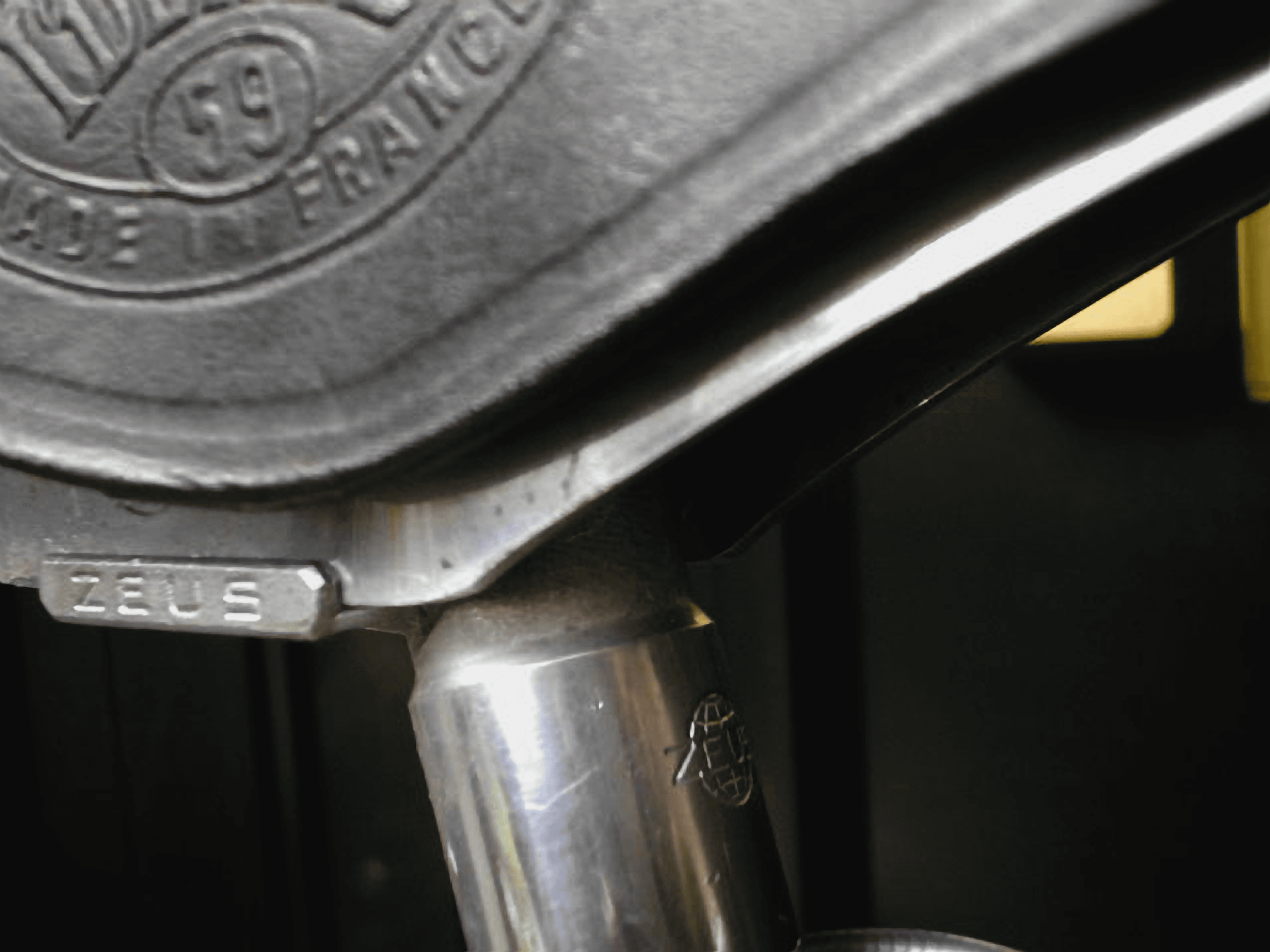
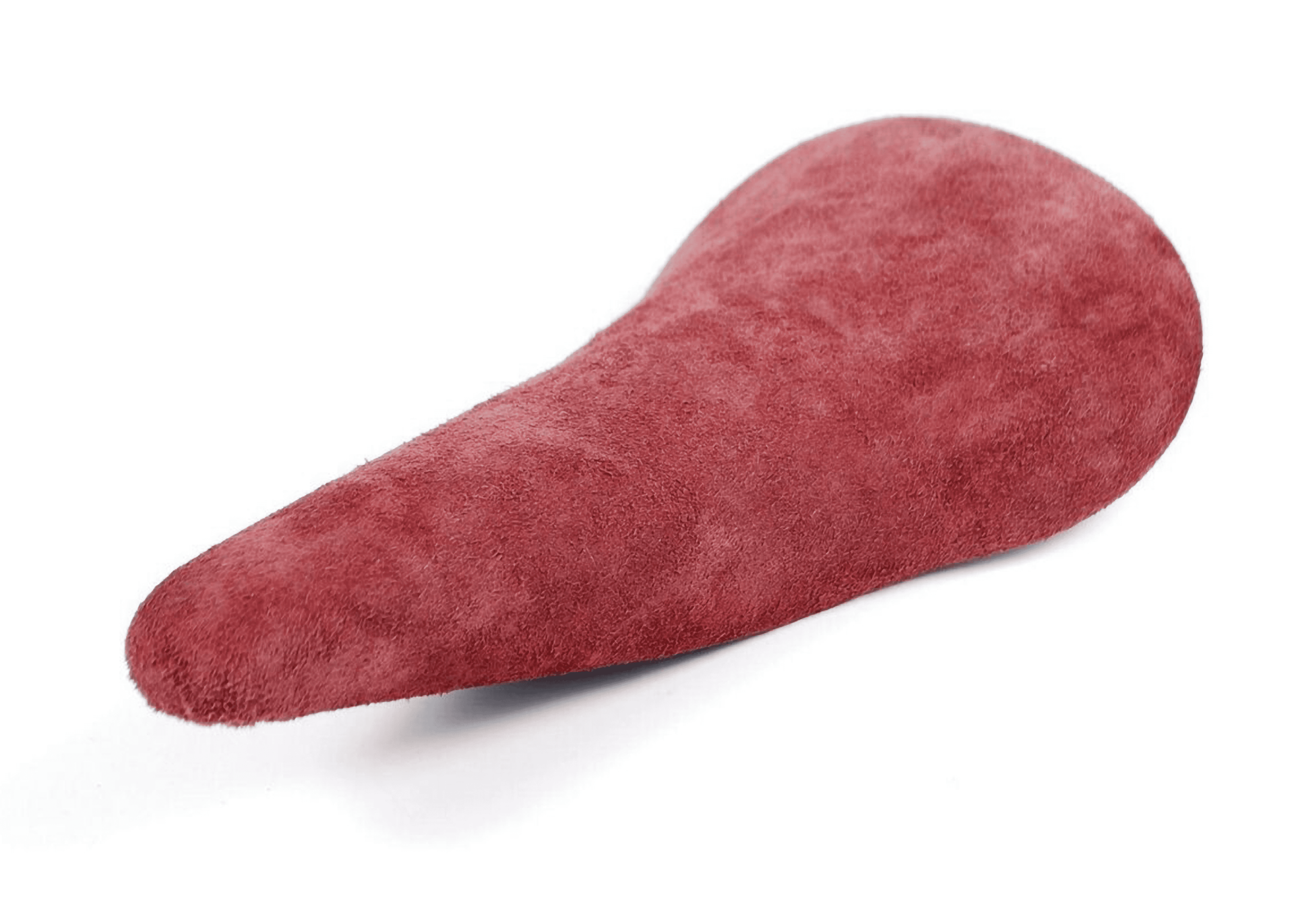
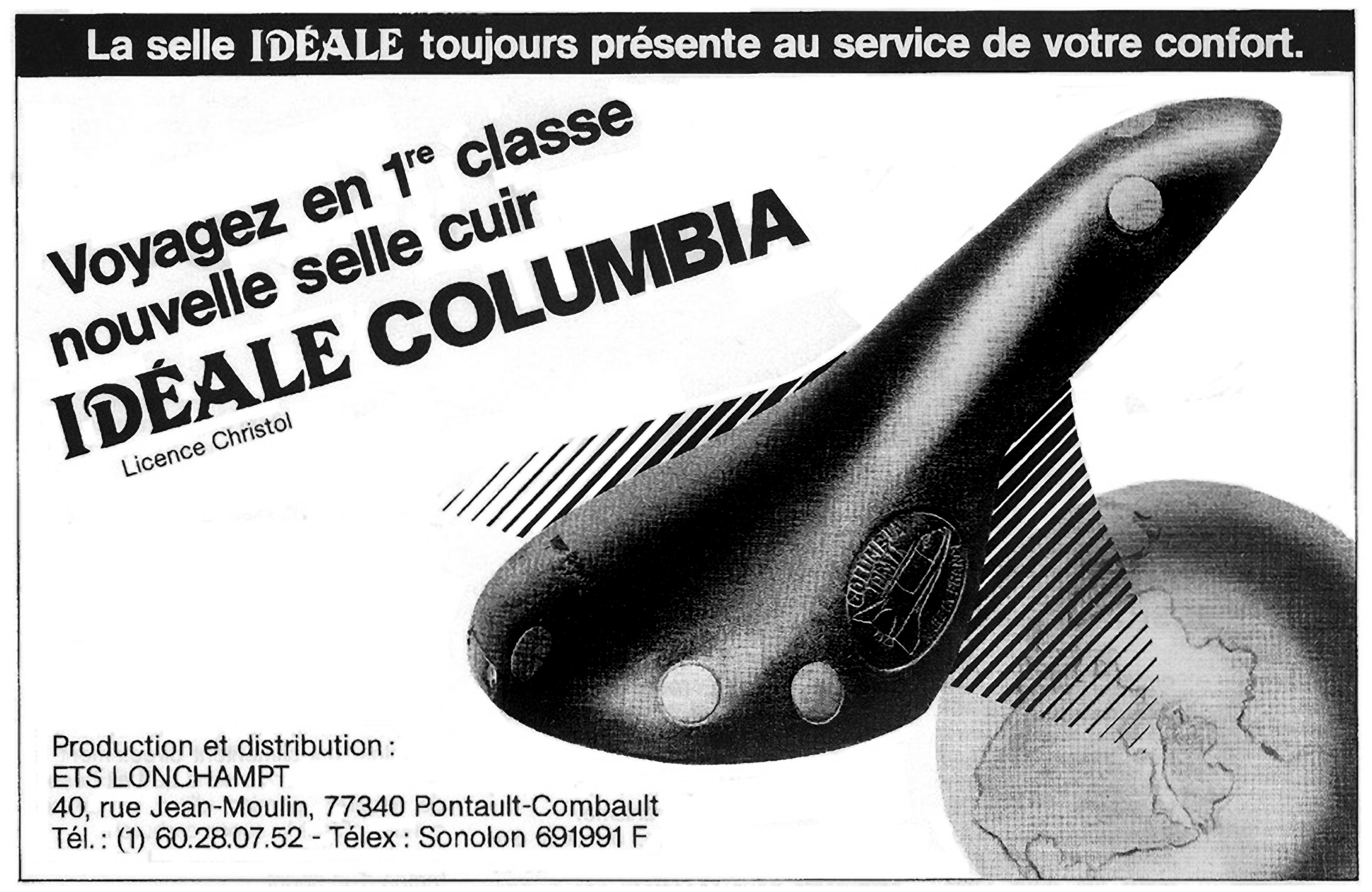
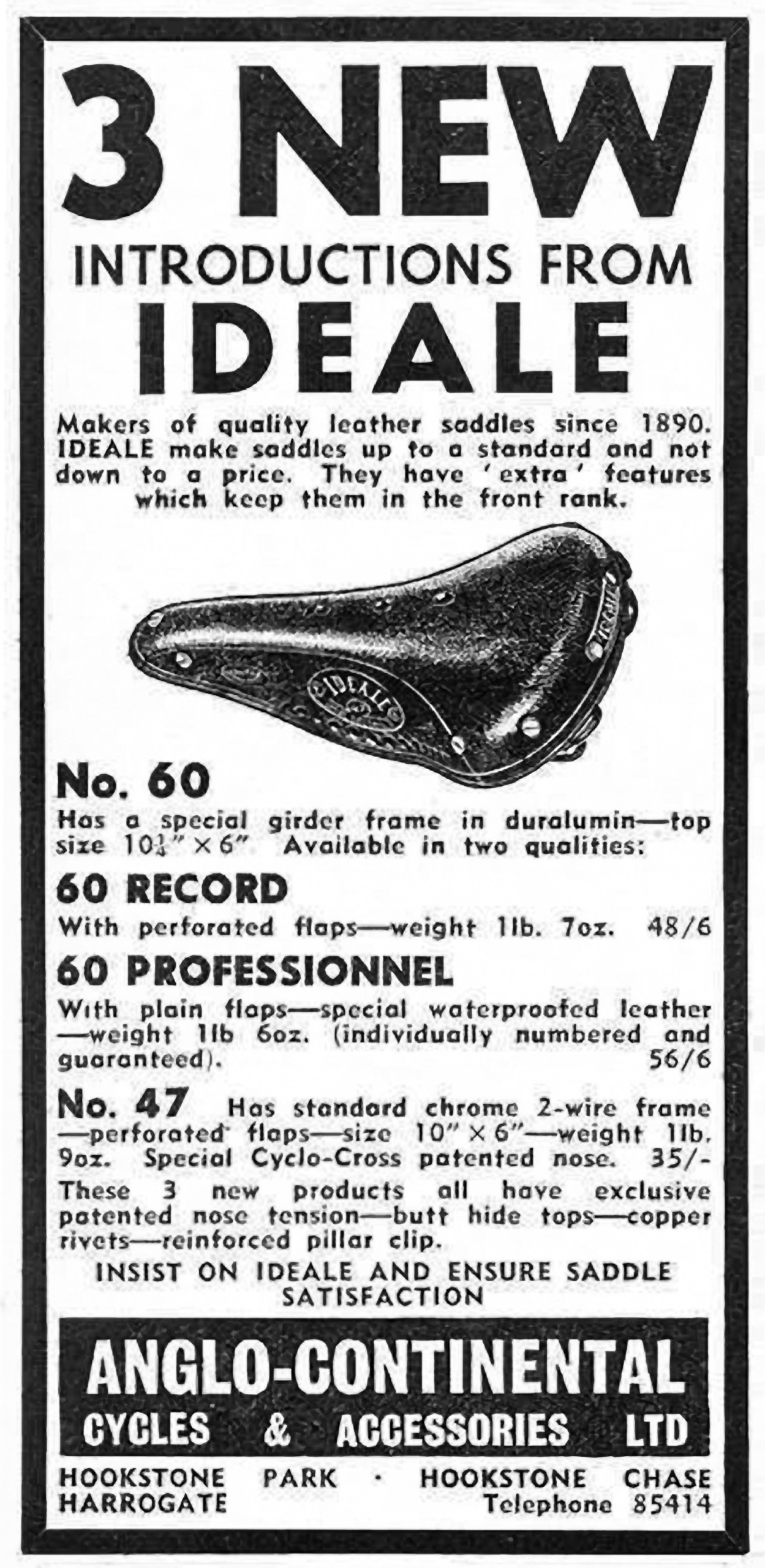
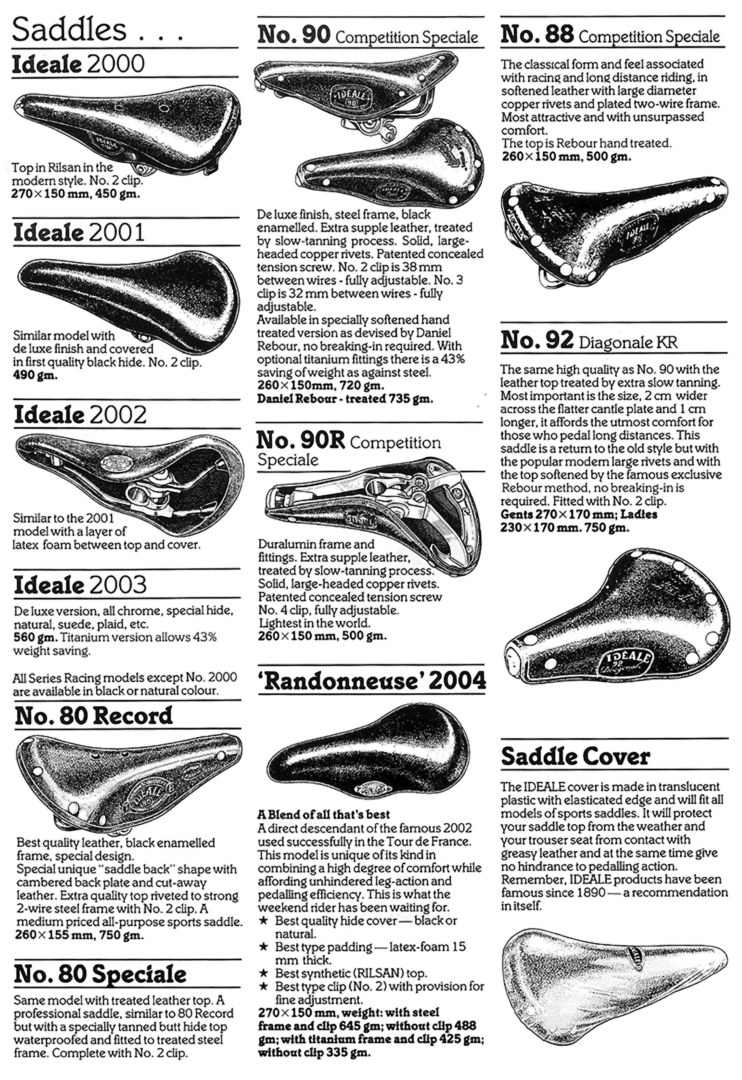
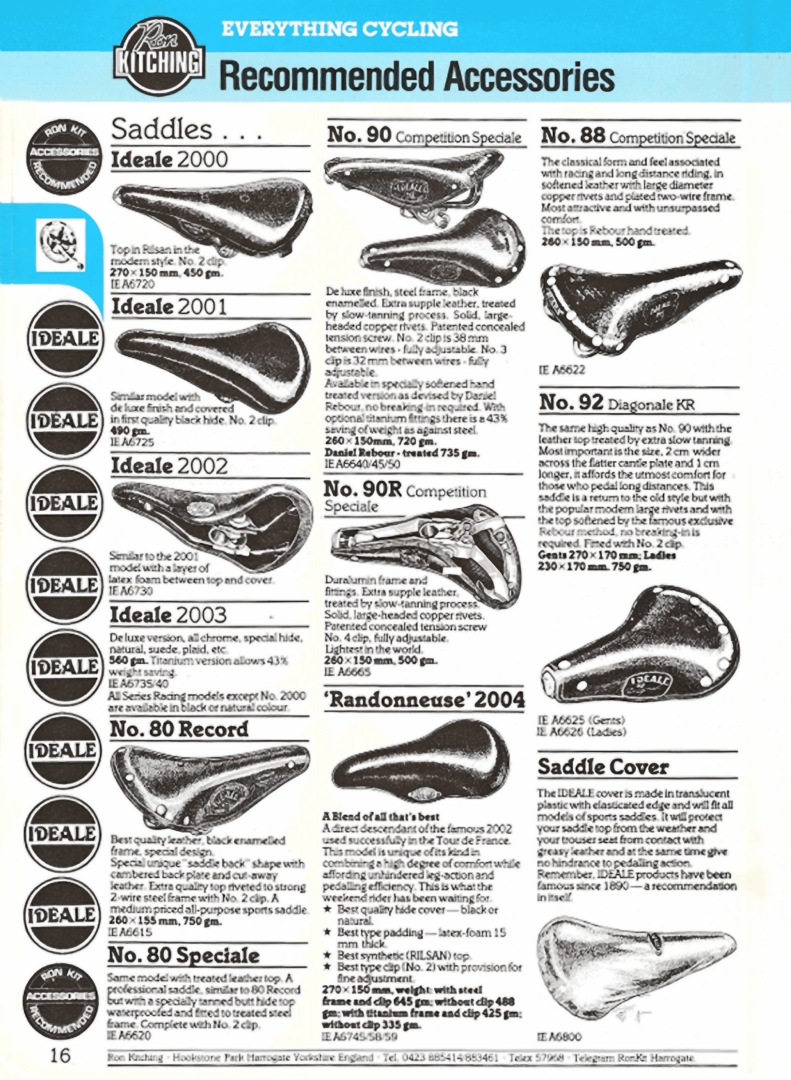
When Gilles Berthoud was considering his own line of saddles he consulted with a senior Ideale staff member of his acquaintance to learn about leather saddle manufacturing. He combined this knowledge of technique with his own innovations to create the beautiful Berthoud saddles that are available today.
Please,I would like your help:I have a saddle ideale but is not possible to learn the stamp saddle completelly
So I think is 1935,and is writing H.G. MEILLEURE?!This is a smaller stamp.Thank you in advance
I logged many thousands of miles on my ideale leather saddle that had taken on the shape of my gluteus maximus from the hours of riding in the rain. I was often asked how can you ride on such a hard seat? Easy, I’d say.
It is our pleasure to inform you that we are going to participate in exhibition ( Eurosatory 16-20 june) in France.
We invite you warmly to visit us and look our beautiful saddles and accessories made by our skilld workers.we have an immense experience in this field. It will be a great honour for us if you visit us.
Please visit and check our samples. We make saddles which are very soothing and comfortable. We can provide all sorts of items on your demand. You will feel a great deal of pleasure if you cooperate with us. You will see that there is no difference between delivered products and our samples. Our products are very reliable and of internation level.
If you have any queries(in saddles Making and need a worker) feel free to contact us.
A .R CORPORATION
TEL:92-547-413289
Mob:92-345-4675078
FAX:92-547-531708
Website(arsaddles.com)
Email:a.r.corp@hotmail.com